UFO
GOVERNMENT RECORDS
HISTORY


GOVERNMENT RECORDS
HISTORY

Trusted Real Estate Professionals that know this market and are ready to help you.













October 2024 | Sanford, North Carolina
A product of LPH Media, LLC Vol. 6 | Issue 10 | No. 67
Editorial
Gordon Anderson | gordon@rantnc.com
Billy Liggett | billy@rantnc.com
Jonathan Owens | jonathan@rantnc.com Richard Sullins | richard@rantnc.com
Advertising Nate Ewing | advertising@rantnc.com | (919) 478-0560
Contributors Matthew Ramey
Editorial Board
Elizabeth Klarer, Antonio Vila Boas, Betty and Barney Hill, Lonnie Zamora, Travis Walton, Robert Taylor, Whitley Strieber and Meng Zhaoguo
Find Us Online: www.rantnc.com
Facebook: facebook.com/therant905 Twitter: twitter.com/therant905 Instagram: instagram.com/therantnc


The Rant Monthly is located in beautiful Sanford, North Carolina. Please address all correspondence to LPH Media LLC, 3096 South Horner Boulevard #126, Sanford, NC, 27332. Editorial email: billy@rantnc.com. Advertising email: gordon@rantnc.com.
The Rant Monthly is published monthly. The Rant Monthly is wholly owned and operated by LPH Media LLC, a North Carolina corporation. Submissions of all kinds are welcome. This publication is free. Removal of this newspaper from any distribution point for purposes other than reading it constitutes theft, and violators are subject to public flogging and ridicule. Printed by the Wilson Times Co. in Wilson, North Carolina. Copyright 2024, LPH Media LLC, all rights reserved.
“They say in the end, everything will be OK. If it’s not OK, it ain’t the end.”


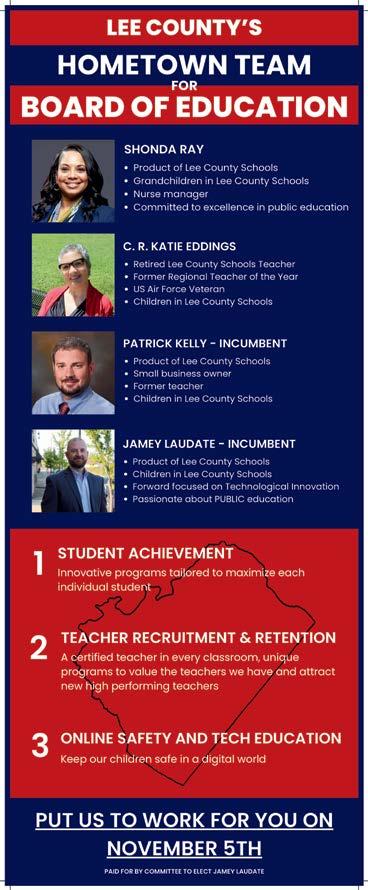
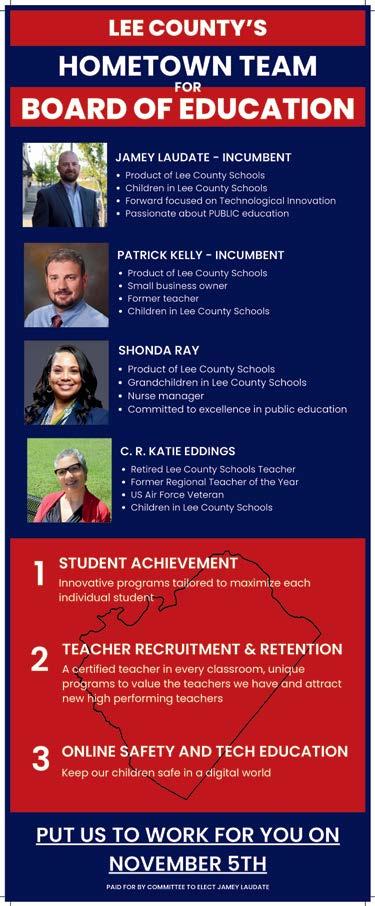
We’re no National Enquirer, but we love a good UFO story
You can make the claim that this months’ edition of The Rant Monthly belongs in the checkout aisle of your local grocery store — next to stories featuring an old Elvis or the return of John F. Kennedy — rather than next to legitimate newspapers.
And we probably wouldn’t argue, because for over five years now, the one thing we haven’t done is take ourselves too seriously.
But the cover story of our October 2024 edition isn’t meant to be sensational or a direct competitor of the National Enquirer. Yes, it’s October and a great time for all things mysterious and spooky, but our feature on UFOs in Sanford is based on very real documents from our very real government.
Unidentified Flying Objects have been a fascination of Americans since the 1940s, when the term “UFO” was coined. Since then, we’ve had Area 51, all sorts of grainy images and tales of alien abductions to capture our imagination.
This month’s story written by Richard Sullins shares documented sightings of inexplicable aircraft and lights in the sky from our fair city, beginning back in 1949 when a U.S. Naval lieutenant chased a white light in his jet 25,000 feet over Sanford. It shares the tale of a Sanford father and son spotting a large triangular object over Lake Jordan roughly 30 years ago.
Our feature comes at a time when UFOs have been national news. In March, the Pentagon went public with a study that admitted

edition of The Rant
stories of UFO sightings in our area over the last 70-plus years, made public by the release of government data on sightings across the country.
thousands of documented sightings over the past 75 years, yet no official evidence of alien life. The release of the government’s database contains some of the Sanford sightings featured this month.
We invite you to read it and decide for yourself if our planet has been visited by life from another solar system. Then look to the skies and be sure to tell us first if you see anything strange.
We’re always up for a good story.
— Billy Liggett






Ten of 14 schools met or exceeded their expected growth, according to annual assessments released in September by the North Carolina State Board of Education. The numbers show a notable increase in the number of schools reaching this milestone as compared to results from the previous school year. Additionally, the number of low-performing schools within the district has decreased.
School Performance Grades include a series of scores based on statewide testing to assess school achievement and growth. Under current state law, a letter grade is assigned to each school. Eighty percent of the grade is based on how well students perform on standardized tests, while the remaining 20 percent is based on growth, defined as how much academic improvement students achieve during the year.
For the seventh consecutive year, Lee Early College earned an A grade. Tramway Elementary also maintained a B grade, which it has earned six times since
the inception of performance grades in 2014. Schools earning a C include B.T. Bullock Elementary, Deep River Elementary, Greenwood Elementary, J. Glenn Edwards Elementary, J.R. Ingram Elementary, Lee County High, SanLee Middle and Southern Lee High.
Several of these schools showed significant improvement over the last year. B.T. Bullock Elementary improved their overall performance grade 10 points, while J. Glenn Edwards improved their overall grade by nine points, including a large jump in student growth of over eight points. Tramway Elementary saw a ninepoint gain in student achievement and Greenwood Elementary, SanLee Middle and Southern Lee High saw notable improvement in regards to student growth.
Four schools received a D or F grade, classifying them as low-performing schools for the current year. Schools receiving a D grade were Broadway Elementary, East Lee Middle and W.B. Wicker Elementary. West Lee Middle School received an F grade.

Tramway Elementary earned another “B” grade from the N.C. State Board of Education this year and saw a nine-point improvement in student achievement from the previous year. “We are excited to see positive gains in overall academic performance” said Superintendent Dr. Chris Dossenbach. “We still have areas where we can improve and have already put many changes in place that we anticipate will lead to even greater results in the coming years.”


For the second time in three years, The Rant earned a first–place award for “Community Coverage” in the statewide online division of the North Carolina Press Association Awards Contest, announced in September.
The award — featuring coverage from Gordon Anderson, Richard Sullins and Billly Liggett — was one of three given to The Rant for its news coverage over the past year. Liggett also earned a first-place award for headline writing and a thirdplace award for sports feature writing.
Since joining the North Carolina Press Association in 2022, The Rant has taken home 12 N.C. Press Awards in the statewide Online category, competing against state media outlets such as Carolina Public Press, The Assembly, North Carolina Health News and Cardinal & Pine. The NCPA’s contest continues to be one of the largest in the country with more than 4,000 entries from over 125 newspapers and news organizations from across the state.
The Association’s “Community Coverage” category recognizes newspapers or outlets who “report news that matters locally to readers and chronicles the essence of their community.” The category judges quality of writing and reporting and coverage of local issues like education, entertainment, sports, religion and more. Judging was based on The Rant’s overall coverage in October of 2023, which included coverage of Grace Christian’s nationally ranked basketball program, Lee County’s “Dream Center” debacle, local protests of “drag shows,” several stories on growth and new housing and business developments and more.
Liggett’s first-place award was for his “Good Night Suite Prince” headline for the story on the long-awaited demolition of the Prince Motel in downtown Sanford. His sports feature award was for a story on Grace Christian’s top basketball recruit Sarah Strong.
“We’re always happy on the rare occasion when real journalists take us seriously,” said Liggett. “Perhaps one day we will even be invited to the ceremony.”
“Awards?” added Gordon Anderson, closing the bubble popping game on his phone. “There are awards?”
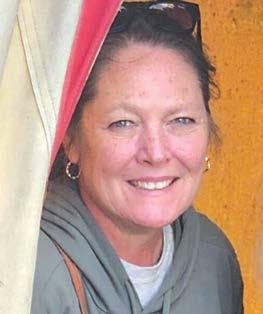


Several friends, family members and community members have posted to social media asking the public to assist in the search for Kim Ashby, who was announced as missing after flooding washed away her and her husband’s Elk Park home in western North Carolina. Footage from a neighbor’s Ring doorbell showed the home being carried away down the Elk River on Sept. 27.
A Sanford woman who teaches at SanLee Middle School is missing after the recent flooding in western North Carolina, according to posts on social media made by her family — and confirmed by the school on Sept. 29.
Kim Ashby and her husband Rod were in Elk Park, less than two miles from the Tennessee state line in Avery County, when flooding caused by Hurricane Helene on Sept. 27 reportedly picked up their house and sent it floating down the Elk River.
According to several posts, Ashby’s husband was found and the home was located after a search on Sept. 27. As of this publication on Sept. 30, Kim Ashby was still listed as missing. Ashby’s sister, Kathy Brown, wrote on Sept. 29 that family
Information in the printed version of this story was up to date as of noon on Monday, Sept. 30. Visit rantnc.com for updates on the search for SanLee Midding School teacher Kim Ashby.
members were “worried sick,” but thanked the community for their love and support during the search.
“It is unreal the devastation that occurred,” she wrote. “Praying for a miracle that my sister will be found safe.”
Ashby’s daughter Jessica Meidinger said a search party went out on Sept. 30, adding, “It’s amazing how much we’ve learned giv-
en how devastating this has been and how little communication has been available.”
At least 64 people have died across Florida, Georgia, Virginia and the Carolinas as a result of Hurricane Helene, which hit Florida as a massive Category 4 storm and made its way north to southern Appalachia, which was hit with unprecedented flooding. Several deaths were a result of drowning, while others were killed in their homes by falling trees or on roads made dangerous by the wind and rain.
The death toll in and around Asheville, North Carolina alone was at 30 on Sept. 29, according to the Asheville Citizen Times. The entire western portion of the state was reeling from flooding, damage caused by the flooding, impassable roads

and widespread power and water outages heading into the new week.
Reports of as many as 500 to 700 people remain unaccounted for in the western part of the state. That number remains high because of communications issues in the region, as more than 500,000 homes and businesses were still without power as of Sept. 30.
News of Ashby’s disappearance reached Lee County Schools officials on Sept. 29.
SanLee Middle School Principal Christian Chaney sent an email to parents that afternoon asking them to join in prayer for her and her family and recognizing that their children may have questions or concerns when they return to school on Monday.
“We are saddened to share the difficult news that Mrs. Ashby, beloved seventh-grade math teacher, is currently missing after the home she and her husband were in during the storm washed away,” Chaney wrote. “As we come together as a community during this time, please know that our staff is available to provide support to students, staff and families who may need it. Additional district staff to include the Mental Health Team, school
counselors and school social workers will also be on campus to provide support during this uncertain time.”
In addition to teaching math at SanLee, Ashby is coach of the school’s chess team and was highlighted in a feature about the game’s growing popularity in Lee County Schools in a feature story from The Rant in June, 2023. In the story, Ashby talked about the joy she received from seeing her students learn the game and get better at it.
“About half the students who join the club have a beginner’s knowledge of chess,” she said. “The improvement I see in just a few short months is amazing. Many of them have quickly advanced and can outplay me now.”
o
Governor Roy Cooper is encouraging donations to the North Carolina Disaster Relief Fund to help communities recover from catastrophic damage caused by Hurricane Helene. To donate to the North Carolina Disaster Relief Fund, visit nc.gov/donate.


Mark Robinson once told an audience at a Moms for Liberty breakfast that perhaps we, as a country, should stop criticizing those who quote Hitler and actually start reading more quotes from strong men like da fuhrer and Joseph Stalin. In 2021, he said a woman’s body is no longer hers when she becomes pregnant, and victims of rape and assault deserved what happened to them under Charles Darwin’s “survival of the fittest” theory. That same year, he referred to LGBTQ+ people as “maggots” and “flies.”
He has referred to Black Democrats as slaves. He called homosexuality an “abominable” sin after 49 people were killed at a shooting in a Florida nightclub frequented by LGBTQ+. He has denied the Holocaust and called Jewish bankers one of the “Four Horsemen of the Apocalypse” (the other three were Muslims, Chinese and the CIA). He’s called the moon landing in 1969 fake. He has publicly called 9-11 an “inside job.”
All of this was prior to the May primary election in North Carolina, where Republican voters had all of this information — the hate, the idiotic statements, the embarrassing headlines — and STILL elected him as the Republican candidate for North Carolina governor in the November election. And he won with nearly 65 percent of the vote.
Of course, Robinson’s downfall since becoming the GOP’s best hope to defeat Josh Stein is widely known. The recent unveiling of past comments he wrote on the message board for a porn website — statements about being a “Black Nazi,” about his admiration for transgender pornography, about peeping on women in public showers as a teen, about threesomes with his wife’s sister — has made him a national laughingstock. And yet, Robinson, who has denied the statements, remains in the race.
The Rant has refrained in past elections from endorsing candidates in local, state and national races. But this one is easy. If you think that Robinson — despite everything listed above — will defend conservative stances on abortion (look up his history) and faith (look up his history), think again.
There simply is no defending a vote for Mark Robinson this November.
A local pastor appeared before the Lee County Board of Commissioners in September to again implore the group to ban “drag queen” shows at any location in the county.
Pastor Thomas Booher of Heritage Reformed Presbyterian Church made a similar request in 2023 after he and several masked protesters — some wearing Nazi and Confederate symbols — protested a drag show event in the Jonesboro Heights area. His most recent appearance led to several comments from Rant readers:
Everyone has their own opinion and is allowed to voice it. This pastor spoke out what he believes — that doesn’t mean it’s the gospel (no pun intended). Protesting is allowed. Drag shows are allowed. Churches are allowed. It’s when those people break the law and/or turn violent because they don’t like what the other “side” is doing. Why do people feel so entitled these days to go to the extreme to make others believe what they believe? … This is why news outlets post stories like this. To create division and sides and anger people so they’ll lash out at others. Sad world.
Lauren Manis
I have a 4-year-old, so I’m also trying to teach her we don’t have to get all bent out of shape when somebody else does something we don’t like.
Jordan Walsh
I applaud this pastor for standing up for godly standards for the community.
Debbie McCane
You know what? He can just not go to the drag show. Problem solved. What other people do or don’t do within the boundaries of legitimate legal activity to have a fun time and even share with their children is their own business. He or no one else has no right to say otherwise. But don’t threaten me with a good time. I’d love to see a drag show.
Claire Oxendine

“I have a (censored) dream.”
The same First Amendment that exists to protect religious speech and practice also exists to protect drag shows and other forms of speech. It’s not a one-way street. If we ban drag shows then we should ��make all churches taxable and put under government scrutiny.
Will Rickard
I know that this town likes to brag about how God-fearing it is. It’s easier to complain and parrot than to do any actual ministry. To better the children, we build mega churches that charge an extortionate amount of money in school tuition, but ignore those in our community who need help and God’s love most.
God is needed in this town in so many ways, and there are so many untouched opportunities to spread the gospel of God’s love. If pastors used their platform for these types of issues, our town would probably flourish. But no, you’re right, drag queens are the problem.
Ruth
So if there’s another pastor/preacher/priest arrested for actually abusing children — as numerous records show — can we all petition to have that church or religion banned? I feel like that would be a lot more effective.
Avis Lazario
The Rant: Everything I don’t like is white supremacy.
Trina Sherina
By Billy Liggett
There’s a TikTok account based out of Sanford where students are encouraged to choose between two named students and declare who would win in a fist fight. Other short videos ask students to “ship or dip” students (for you boomers, that means determine if they should be in a relationship). At least one post encouraged students to volunteer to be “rated” on a scale of 1-5 stars, with five being the “hottest.”
These accounts and pages are everywhere, of course. Our middle schools have pages dedicated to fight videos. Schools across the country are dealing with accounts that champion bullying or destruction of school property.

Considering the endless stream of terrible things that exist on the internet and social media, this TikTok page might seem innocent and harmless enough. Until, that is, you realize the school in question is a local elementary school. The students you’re being asked to pick in a fight, pair up with another student or rate on a hotness scale are mostly fourth and fifth graders.
The students asking for their looks to be graded by others haven’t even hit puberty yet.
It all makes a parent want to keep social media out of their child’s lives as long as possible, right?
Well, a book that came highly recommended to me suggests just that, and it has mountains of statistics to justify the suggestion.
“The Anxious Generation: How the Great Rewiring of Childhood is Causing an Epidemic of Mental Illness” by Jonathan Haidt tells the very real story of how smart phones, social media and changes in the way we parent have led to a decline in the mental health of our children. It also offers ideas for solutions to raising the next generation to become emotionally stable adults.
“The Anxious Generation” leans heavily on studies and charts that show a significant rise in anxiety, depression and ADHD among children and teenagers beginning in 2010 — anxiety rose 134 percent from
2008 to 2020 and depression 106 percent. Self-harm and suicides also saw a steep rise in that time period, particularly among 18-25 year olds.
It poses the question: What exactly happened to young people in the early 2010s? Then it gives a very quick answer: smartphones and social media.
Haidt calls this period “The Great Rewiring of Childhood,” a time when screens became a substitute for play and parents became overprotective of their children outdoors while remaining underprotective of their online safety.
His solutions to fixing things may seem obvious. No smartphones until high school. No social media until (at least) high school. Encourage play. Embed children in more “real-world” situations. There’s more, of course. I won’t spoil the ending.
It made me step back and rethink how I raise my kids. And while I’m not here to say you’re doing it wrong, I do hope you join me in seeing the light.
o
Email Billy Liggett at billy@rantnc.com.


A HISTORY OF THE UNEXPLAINED
Government files show that Sanford was among the first American cities to report a UFO encounter and played a critical role in the government’s decision in the early 1950s to investigate what people were seeing and assess their potential threat. Image created in Midjourney
U.S. GOVERNMENT RECORDS REVEAL THAT SANFORD HAS BEEN HOME TO MULTIPLE ‘UNIDENTIFIED FLYING OBJECTS’ AND PLAYED A ROLE IN THE COUNTRY’S EARLY RESPONSE TO SIGHTINGS
BY RICHARD SULLINS
It’s a story that could easily have been used as the opening scene for an episode of the X-Files, back when Mulder and Scully ruled broadcast television. Set in the backwoods of Sanford, North Carolina, a father and son are returning home after an athletic competition on the western fringes of the Triangle. It’s been a long and full day for each of them, capped off by the dad playing well in his game tonight. Now, they’re heading home, and the end of this day might have been as it has been for them so many times before — the uninterrupted minutes dad and his son got to spend together away from anything else competing for their attention.
It was a decade before cell phones took away almost all of our privacies, including the ones that allowed others to reach us most anywhere — and often for the most trivial of reasons. Even today, people who report experiences like these two men were about to have are frequently ridiculed for reporting what they saw, and have their lives turned upside down because of it. For that reason, we will call the dad “Steve” and his son “Julian.”
The days were getting shorter, and the sun had set hours before. Because of the lateness of the hour, Steve decided that instead of taking the more conventional Interstate 40 East to U.S. 1 to Sanford route, they would follow an alternate track that will skirt the western edges of Jordan Lake because the miles were fewer and if luck was on their side, they’d make it home faster, too.

The image from video provided by the Department of Defense in 2021 shows an unexplained object as it soars high along the clouds, traveling against the wind. This year, the Pentagon announced that after decades of government investigations into UFO sightings, no evidence was found that any of the sightings were extraterrestrial.
It’s a road Steve knows well, having traveled it many times for both work and pleasure. But nature was making it extra-special on this night, with an incredible display of beauty as the leaves were beginning to put on a show of colors that comes but once each as they headed south ultimately to an intersection with U.S. 1 at Pea Ridge Road, much closer to Sanford than the I-40 to I-440 route that would have taken them almost into Raleigh before turning southwest, adding extra time and miles.
As they came to a bridge that crossed one of the many fingers of Jordan Lake, the two noticed a large triangular object ahead of them, hovering out over the water. Steve slowed the truck to a near stop over the bridge, both of them frozen by what they were seeing. There was hardly a sound being emitted by the black triangle with white lights at each of the three corners. They didn’t perceive a threat, so they crossed the bridge and got out of the truck to observe it more closely.
A few minutes later, the approach of a large truck from the opposite direction resulted in the object moving closer to land and dropping slowly into a grove of trees.

The flying saucer reported by a pilot, Kenneth A. Arnold, was given the term “UFO” or “unidentified flying object.” UFO was used to describe any aerial object that was seen but not identified.
What made this action even more significant was that the object didn’t look for a clearing to just land. Instead, its matter seemed to merge with that of the trees, so that the two masses became one.
After the object disappeared into the darkness of the night, Steve and Julian returned to their pickup and continued their trip south toward Sanford. The hour was getting late and what they had just seen had their minds going full throttle, so Julian leaned against the seat and tried to get a few minutes of shuteye. But after seeing something that neither of them could explain, how
could he begin to relax?
Steve was also trying to turn their strange experience of a few miles back over and over in his mind, hoping to make some sense of what it all meant. But that was the problem - nothing about it made any sense at all. Tomorrow was going to be as much of a long day for Steve as this one had been, and sleep was going to be as difficult for him as it would be for his son.
These thoughts continued to fly through his mind as the pickup approached yet another jetty of land that, like the first,

know that more than half of Americans don’t know how much they’ll need to retire comfortably? A reverse mortgage could help. To qualify: Reverse mortgage benefits:
• Eliminates monthly mortgage payments for life*
• Access to more cash flow
• Greater financial security
• Bulk up retirement savings
• Non-recourse loan, meaning you’ll never owe more than the appraised value of your home when the loan is due
• Heirs still have an opportunity to inherit the home and potential leftover equity
• You must be at least 62 years old
• Continue paying property taxes, insurance and HOA dues
• Maintain the home in good condition
• Occupy the home as your primary residence
• Attend a HUD-approved counseling session
connected two larger portions that had been saved from being flooded when the lake finished filling in 1982.
That’s when Julian looked out the back window of the truck and saw the same shape he’d seen earlier, appearing to follow them along the treeline. This time, there were two of the objects instead of just one.
Side by side, they maintained their positions as if they were holding formation for several minutes. Julian still believes they were being studied by the occupants of these objects, but he also believes that he and his dad were not perceived as a threat. Then, one of the objects began to turn slowly as it rose into the sky and moved off into the opposite direction.
And like the grand finale at a fireworks show on the Fourth of July, the most mind-blowing part came at the very end. Julian told me that the second of the two objects also rose slightly into the air of the nighttime sky and “blinked,” explaining that it was similar to what you might see on “Star Trek” when a ship goes into warp drive. The Enterprise is there, there’s a blink of bright light, and then it’s gone.



“That’s what happened,” he said. It’s been more than 30 years since Steve and Julian’s experience on the shores of Jordan Lake, but the details remain fresh for them. And regardless of what you might believe about unexplained objects in the sky, what this father and son saw is still one hell of a story, particularly as you put it into context with reports that have been made by others who have seen some of the same things in this area over the last 75 years.
There’s a certain stigma often applied to people who tell others they have seen something, often in the skies, that they can’t explain. Maybe it was a UFO. Maybe it was Sasquatch. How about the Brown Mountain Lights? Two things tie many of these stories together. First, they defy most attempts to explain them with science, and secondly, those of us who didn’t actually see the event are asked to accept them on blind faith, even if they contain elements our minds have been trained to believe simply cannot be true. They ask us to believe stories of objects that bend the laws of physics in ways that our minds can’t comprehend.
They push the boundaries of how we know things work in the universe, and so those who tell such stories without the obvious difficulties that the rest of us have in accepting them as being within the realm of believability — these storytellers often push us beyond our comfort zones, and because the universe tells us that such things cannot be that way, we must dismiss them and the stories they tell.
But maybe we shouldn’t do that so quickly.
As Sanford continues to celebrate its sesquicentennial in 2024, almost any of us who live here could spend a couple of hours at the library and come away with a book report piece laying out some of the more familiar stories about Sanford’s history that many of us have heard before.
But maybe looking elsewhere can lead to a gem that few are familiar with.
One of Sanford’s unspoken legacies is that it’s a city with a surprising number of claims about unidentified flying objects, UFOs, UAPs — or whatever you might wish to call them. They’re tales fitting for an October edition of a monthly news publication, at a time of year when “spooky” is appropriate.

Popular October event in downtown Sanford adds even more to do this year

OCT. 18-19
Join us on a hunted foodie adventure right here in Sanford. This 2.5-hour walking tour will take you to five local restaurants, breweries and sweet treat spots to indulge in delicious snacks. Along the way, you’ll get the chance to explore the area’s spooky and mysterious history through entertaining ghost stories.

OCT. 24-26
Step into the eerie past with a historical walking tour of Sanford, where history and hauntings intertwine. Hear spine-chilling tales of five ghosts said to roam the city’s most iconic buildings, from restless spirits in a long-closed furniture store to mysterious apparitions haunting a former train station.

OCT. 17 & 31
Savor the flavors of downtown Sanford with a tour featuring staffrecommended bites from the area’s most beloved restaurants. Five eerie ghost stories can also add a haunting twist to your tasting adventure. Be sure to get your culinary map at participating restaurants or the Sanford Welcome Center.
It’s important to know how The Rant chose to approach this story. We could have posted something to social media reading “if you’ve ever seen a UFO, call us up and tell us about it.” No doubt, our inbox would have been filled with messages, some credible, but many from drunk uncles full of fantastical and outlandish claims.
As interesting as that might have been, that wasn’t what we were looking for.
First and foremost, this has been a data-driven search. As hard as it might be to believe, scientific studies on unexplained visual sightings have existed since the early 1950s. They have been cataloged and are digitally searchable, and that’s how we found the very first recorded sighting of a UFO in Sanford.
In that same year, the U.S. Air Force began its investigation of the phenomena called Project Blue Book that ran through 1969. There is some crazy stuff in there. Believe it or not.
People who saw objects in the sky they couldn’t explain often contacted the FBI and CIA. Their public “reading rooms”, also digi-

Perhaps this explains Sanford’s sightings — the U.S. military and intelligence personnel have been reporting a large number of UFOs and other aerial phenomena since the 1950s near nuclear sites.
tally searchable, provided much information. By the late 1950s, a feeling of mistrust was building against the federal government, and citizen-organized groups like NUFORC (the National UFO Reporting Center) and MUFON (Mutual UFO Network) emerged as alternative sources of information as people searched for answers to what they had seen.
Because these groups are staffed by volunteers, their work of cataloging sightings is slow, but it also can be a source for rich details that include photographs and videos.
There are also interviews, admittedly few because the number of people who have seen something unexplainable and are willing to talk about it are contained in a small universe. But we located some people who believe the public has a need to know what they personally experienced, and so we tell their stories, verifying the details as far as we were able to do.
As with anything we publish, we trust our readers to make the ultimate judgment on the stories we share, as well as their value to the collective good.
It’s hard for most of us to think of Sanford as being a “hot spot” for UFO activity. We’d prefer instead to think that anything unexplained in the skies above us is more likely to be the latest technology arriving from Hollywood, bound for a television series or a movie theater.
But that’s not what history tells us. Those government files, some of them just now having been opened for research by the National Archives earlier in 2024, tell us that Sanford was among the first American cities to report a UFO encounter, and what’s more, it also played a critical role in the U.S. government’s decision in the early 1950’s to investigate what people were seeing in the skies and assess whether they were a threat to our national security.
Unexplained objects in the sky go back almost to the very beginnings of recorded time itself. The Old Testament prophet Ezekiel, for example, tells of seeing a great wheel in the sky about 3,700 years ago. In almost every age and in every location where

civilization flourished, there are reported accounts of things in the heavens that defy an easy explanation.
By World War II, as Allied planes were beginning to turn the tide against Nazi Germany’s Luftwaffe over Europe, American and British pilots began to report encounters with unknown objects they labeled “foo fighters.” In 1947, two years after the war ended, a civilian pilot named Kenneth Arnold said he observed nine objects in the sky near Mount Ranier in Washington State, all flying in close formation. It was the Arnold sighting that led to the birth of the term “flying saucer.”
Three years later, on July 19, 1952, in Washington, D.C., the evening radar operator at National Airport reported a dozen or more of these unidentified objects above the city. The Air Force’s brand-new F-86 Sabre jets were scrambled from nearby Air Force bases, but they find that they are no match for the maneuverability and speed of what they face over the nation’s capital. A nearly identical event happens again over the capital on the following Saturday evening, and with the same result.
By the time of the second D.C. encounter, other reports were coming in from a few other locations up and down the East Coast. One of those accounts was filed by a farmer on the outskirts of Sanford, who claimed to have seen a bright light or object holding position over his field. The farmer described the object as a metallic, disc-shaped craft that hovered silently over his field for almost a full minute before moving away at a high speed.
This sighting was reported by the farmer to one of the state’s two North Carolina Senators in Washington, Willis D. Smith. Smith’s papers were donated to Duke University after his death, and among the records of his telephone calls received on July 23, 1952, is a note of a call from a person who did not give his name, just that he was a farmer from Sanford who gave the details reported here.
The note contained a handwritten notation at the bottom, apparently from Senator Smith to his secretary, to “set up mtg (meeting) with Finletr.” Thomas K. Finletter was Secretary of the Air Force at the time, and the Senator’s calendar indicates that the two met on the afternoon of July 29. These reports were taken seriously due to the Cold War context, where any unidentified aerial

phenomena were of significant interest to national security. The 1952 UFO incident in D.C. included numerous sightings of similar objects across the country like the one in Sanford, leading to widespread media coverage and public fascination.
Months later, the Air Force announced it was opening an official investigation into the nature of the sightings being reported across the country, largely as part of an effort to determine whether they constituted a threat to national security. That investigation, known as Project Blue Book, looked at more than 12,500 sightings through December of 1969. Of that number, 701 sightings — including the one reported by the farmer over his field in Sanford — remained unexplained.
As the number of sightings increased during the period from the 1960s through the 1980s, several residents in the Sanford area claimed to have seen peculiar objects in the sky that did not look like conventional aircraft or follow flight patterns typical of the
ways airplanes of that time period behaved. In 1963, a class of school children and their teacher outside on the playground reported seeing a saucer-shaped craft hovering over a neighboring field just before flew away at an astounding speed. A group of early UFO researchers came to the city from Raleigh to investigate this report.
Another group also came from Raleigh to talk to motorists who had traveled along U.S. 1 in the spring of 1975. They each had seen a large, glowing object that seemed to follow their cars for several miles toward Sanford before suddenly disappearing. This report was unique in the period. None of the motorists had been acquainted with the others before the day of the incident.
They were also unanimous in their report of the object having a dome-shaped top and a light that seemed to pulse on and off. A loud humming noise could be heard near the object as it got closer, and the witnesses also reported feeling disoriented from their encounter. Several of them filed reports with the Lee County Sheriff’s Office, but there is no documentation on any conclusion that may have been reached.



In 1996, a group of people who were camping just outside the city limits north of Sanford saw a series of bright orbs in the night sky that formed triangular shapes, not unlike what Steve and Julian had seen less than ten miles north of their position four years earlier. The objects moved in unison before disappearing one by one.
Investigators from MUFON were brought in to interview the witnesses and while no definitive conclusions were reached, the triangular objects seen by those campers in 1996 remain unexplained.
As digital cameras and camcorders came into vogue in the early 2000s, the number of UFO sightings that could be documented by photographs and videos increased dramatically. The MUFON files contain one of the more important sightings from anywhere across America, when a Sanford resident captured both digital images and video of a series of red and blue lights that moved in erratic patterns above his property in 2004 that could not be attributed to known aircraft. The footage was submitted to MUFON for investigation, and investigators there declared it to be “unexplainable by conventional means.”
This case was among those that moved Sanford’s status to a UFO hotspot in North Carolina.
One of the more interesting things about these sorts of reports is that they show no signs of slowing down. Just as the COVID-19 pandemic got underway in 2020, a family living on the outskirts of Sanford reported encounters with an unknown object over several nights. They described a cigar-shaped craft that seemed to be the source of a low-frequency hum, and this family came to believe over the course of these evenings that the object was observing their property. Again, MUFON was called to investigate but no definitive explanation could be reached.
And Sanfordians were not restricted to being at home in Lee County to encountering something in the sky they could not explain. Noah Gunter, who now works with the airplanes that come and go at the Raleigh Executive Jetport just outside Sanford, was 15 when he was vacationing with family at Surf City. He was up early one morning and looking out the kitchen window as he was cooking breakfast.
Suddenly, he saw an object that had just appeared outside his window and over the window.
“It was a metallic disc, maybe a hundred feet wide, and it seemed like it was miles off the coast,” he said. “It was moving slightly back and forth, from one side to the other. It was reflecting the light of the sun, so I felt certain that it was metallic. It just hung there for 15 or 20 minutes, then it shot straight up into the sky and out of sight.”

The U.S. Government received a total of 12,618 UFO sightings from 1948-69. Most were attributed to manmade objects like weather balloons. However, 701 are unexplained to this day.
Whether it’s MUFON, NUFORC, NICAP or some other group that looks into these events, investigators are always most anxious to talk to pilots who have seen things in the sky that they can’t explain. Pilots are trained to be observers of all that is around them. Many commercial and private pilots got their initial cockpit training from the military, and these folks have seen almost anything and everything there is to see that is moving in the air above, below, or around them.
In doing research over the summer in preparation for this story, I spent many, many hours reading through reports of the strange and weird over the skies above Sanford that were submitted by pilots when they returned to the ground. It’s really important to remember here the risks that pilots were taking by reporting what they saw. Until recently, a pilot could be laughed out of the cockpit or declared unhinged for telling what they saw. In the 1940s and 1950s, doing so could equal the end of a pilot’s career.
Making such a report in that era would almost have been an act of desperation by a professional pilot who was so concerned for his colleagues and his country’s security that he would risk his own career to report what he saw. Here are just a few excerpts of some of these reports made by both commercial and military in the skies above or near Sanford during that era: October 23, 1949 – 4:38 p.m. Flying over Sanford in his P-47 high altitude fighter aircraft, U.S. Naval Reserve Lt. Cdr. Frederick Carr spots a round, white shining object at 25,000 feet and traveling southwest at a speed the P-47 cannot begin to match. Though he immediately gave chase, Carr can only dream of catching up and his visibility of the object was less than 15 seconds.
December 29, 1949 – approximately 5:00 p.m. Four military pilots on a training mission take the long loop from Columbia, South Carolina to Greensboro in their light training planes see a blimp-shaped object in the skies over the western fringes of Sanford. The training aircraft attempt to keep up with the object, but the object will only allow the trainees to keep up for so long. About a minute after rendezvousing with the object, it immediately accelerates and out distances the new pilots at high speed.
October 15, 1950 – Over Sanford and crossing into Pope AFB – 4:20 p.m. Miami Airlines Pilot Captain George Woodward and Co-Pilot Williams Bradsley, en route from Raleigh to Miami in a DC-3, observe four “shiny-domed discs” about 100 feet in size each and about 25 feet apart approximately five miles ahead of them traveling in a straight line.
Captain Woodward gives pursuit, and the objects slow and decrease their altitude before leaving “in a burst of speed.” On the ground, retired Army Captain Harvey Daniel sees an object identical to the one observed by the Miami Airlines pilots. Daniels sees the

‘UFO’
The term UFO refers to any unexplained object or light in the sky. It is not a term to describe an alien being. Almost all UFO sightings are simply unidentified flying objects ... as far as we know ;)
object for about 10 seconds before it, too, speeds off toward the northwest. If one were to draw straight lines between the objects at the times they were observed, those lines would intersect near the point where the Deep River empties into the Cape Fear River.
October 23, 1950 – 12:42 p.m. One year to the day since Carr’s encounter, ex-USAF pilot Frank Risher is driving on U.S. 421 South. He has passed Bonlee and is less than 7 minutes northwest of Sanford. He sees what appears to be an aluminum object about 2 miles ahead of him, hanging below
overcast clouds at about 700 feet above the ground. The object is cigar-shaped and about 100 feet in length, with three to four portholes on each side.
It hovers above him for about 35 seconds and drifts upward, back into the thick cloud cover and disappears.
Some 75 years after some of these events, the names of some of the pilots involved in these incidents remain classified. The Air Force considers their release too great a risk for national security.
This story could have been much longer. There are reports of four objects seen in and around Broadway over the past 20 years that I didn’t get to here, and it’s simply because this article was about what has happened in Sanford.
I didn’t stop to count the number of reports of objects seen near Fort Liberty (Bragg). There were easily a hundred or more, and those are just the ones reported by civilians living on or near the base. The Fort has never been known as a site for the testing of experimental aircraft, but there are a small handful of reports involving aircraft being seen there that can give you what my wife calls the “weebee jeebees.” If those things are not ours, then they belong to the Russians, the Chinese, or from a point of origin somewhere outside this solar system. Or they aren’t what they appeared to be at all.
When Sanford’s Sesquicentennial Year winds down, those of us who call Brick City home can hold our heads high for yet another reason. If the reports represent ET first began making his visits to the Third Rock from the Sun (a big if, of course), Sanford was one of the first places he wanted to visit.

A local pastor appeared for a second time before the Lee County Board of Commissioners in September to implore them to ban so-called “drag queen” shows at any location within the county.
The board’s membership, however, showed little appetite for taking any action.
In October 2023, Pastor Thomas F. Booher of the Heritage Reformed Presbyterian Church addressed the commissioners the day after he, his father, another church member, along with several masked persons sporting Nazi and Confederate gear showed up at the Sanford Yoga and Community Center in Jonesboro to protest what was billed as a “drag queen story hour.”
This time, Booher and his father, Thomas C. Booher, requested to speak to the commissioners about that same event of 11 months ago. Although the Yoga Center has an event scheduled for September 22 called “Impersonations,” its advertisements make no references to children being invited and there is no apparent connection with the show and the request of the Boohers to be heard by the Lee County Commissioners.
Booher’s father, a ruling elder at the church, said his group circulated a petition after appearing before the commissioners in 2023 asking for the adoption of a county ordinance to prohibit drag shows, particularly those that were open to children. The petition received about 265 signatures. Booher said human government is based on the precepts contained in the Old and New Testaments, and that ignoring those teachings could result in God “cursing” a community.
The younger Booher reminded the commissioners of last October’s story hour, but he was unable to definitively say what took place inside the Yoga Center. Because he didn’t go inside to see the program, his knowledge of what went on was limited to Facebook posts.
Booher, who voter rolls show lives in Harnett County, questioned whether the Sanford community would allow children to visit an establishment in order to read books that would “groom and bring them into this same depraved lifestyle.”
— Richard Sullins

By Billy Liggett billy@rantnc.com
The goal of the inaugural Triple Crown Charity Car Show — held in September last year at the Dennis A. Wicker Civic Center — was simple: Build on Sanford’s growing car culture by offering an annual event that both celebrates that community and gives back to it.
Despite the day being partly marred by severe thunderstorms, organizers of the show — who modeled the concept after the highly popular Cars & Coffee events in Morrisville — called the first event a huge success. In addition to the dozens of rarities and exotics on display, Triple Crown drew more than 150 vehicles for judging and raised more than $13,000 split between the Christian United Outreach Center in Lee County, Central Carolina Community College’s Automotive
Restoration program and the Lee County Education Foundation.
According to co-organizer Jonathon Nowell, this year’s show — slated for 9 a.m. to 3 p.m. on Oct. 12 (again at the Civic Center). Admission to see the hundreds of outdoor vehicles on display is free, and it’s $5 to visit inside auditorium area to see the 31 “selects” on display, which this year will include a 1971 Camaro with a procharger, a twin turbo-charged 1971 Ford F100 (winner of a SEMA award), Lamborghinis, a Cobra, rare Porches and more.
“We did the math again, and of the 31 cars in the building, the total worth is roughly $15 million,” Nowell said. “And the selects we’ll have just outside of the building are some of the nicest builds in our area. It’s going to be a great display.”
If the weather is improved this year — and much-too-early forecasts that weekend
call for sunny and 75 degrees — Nowell said organizers are hoping for as many as 400 cars on the lot, with owners having the opportunity to opt in for judging. New this year, he said, will be more games and prizes for kids in attendance — CCCC will bring its 80-foot-long CO2 cartridge derby racing track, and small model car kits will be available. More intricate model cars and Lego models will be on display inside the lobby of the Civic Center, outside of the “selects” auditorium.
Another new feature — an outdoor tractor show with roughly 15 to 20 entries.
Nowell said the goal this year is to build on last year’s success and continue to build the community and event and make it a destination for car-lovers.
“We’re always amazed at how far people will drive to come to Sanford and talk about cars,” he said, referring to the
monthly Cruise’N events at Camelback Brewing and the now annual Triple Crown show. “It’s definitely a tight community, and it’s growing.”
o
The second annual Triple Crown Charity Car Show — presented by B&R Hauling of Sanford — will run from 9 a.m. to 3 p.m. on Oct. 12 at the Civic Center and will feature 31 “select” models indoors (admission is $5), 30 outdoor select models, an open judged car show featuring hundreds of entries, events for children and adults, door prizes, food trucks, a live DJ, a tractor show and more. Learn more by visiting the event’s page on Facebook.

Lamborghinis, Porches and other “super cars” will be among the 31 “select” vehicles on display inside the Dennis A. Wicker Civic Center on Oct. 12 at the Triple Crown Charity Car Show. Admission is free to view the 30-plus selects and hundreds of judged cars outdoors, but cost is $5 to view the indoor vehicles, valued at roughly $15 million combined this year, according to organizers.



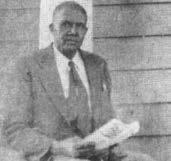
The Sanford Railroad House Museum will lead a tour of some of Sanford’s earliest homes and other buildings on Oct. 6.
Arnold Lincoln “Link” Boykin built several historic homes in the early 1900s in the area surrounding downtown Sanford, many of which still stand today, as well as Fair Promise AME Zion Church at 712 Wall St. and the original W.B. Wicker School on Vance Street. The tour is free to the public and will take place at 2 p.m. beginning in the sanctuary at Fair Promise.
According to materials provided by the Railroad House, Boykin — who along with educator W.B. Wicker is memorialized in a mural on Horner Boulevard honoring Sanford’s early African American leaders — was born in Sampson County and moved to the Cameron area early in life. He began working a construction job with the Augusta Airline Railroad, where it’s speculated that he began honing his skills as a builder.
Boykin moved to Sanford about 1895 and built his own first house at 102 Pearl St. in 1912, as well as Fair Promise parsonage at 408 Ramseur St. A founding member of Fair Promise, he built the existing church building in 1923-24. He was involved in several other buildings in Sanford including the 1936-37 Sanford Post Office (now La Dolce Vita restaurant), and the early brick tobacco warehouses around town.
Stops on the tour include Boykin’s second home, at 705 Wall St., a 1920 home at 318 Cross St., a 1922 Craftsman home at 220 Gulf St., a 1928 Tudor Revival at 506 Sunset Drive, and a 1926 Mediterranean style home at 503 Sunset Drive. The final stop on the tour is the W.B. Wicker School at 806 S. Vance St. — Email patterson@windstream.net
By Richard Sullins richard@rantnc.com
The Lee County Board of Commissioners voted 5-1 to approve $28 million in bonds that will fund construction costs and outfitting of the county’s new library. This state-of-the-art learning center will be located just off Bragg Boulevard in Sanford adjacent to the O.T. Sloan Park.
The bonds contained no requirements for a timetable of repayment or a disclosure of the associated interest rates that would accrue over the loan’s lifetime.
But the financing package has another purpose, one designed to pay for the purchase and installation of radio equipment for the Voice Interoperability Plan for Emergency Responders system across the county for emergency responding units, an item that has been recommended for years but remained fiscally out-of-reach until its inclusion now in the bond package.
VIPER allows public safety agencies to talk to one another via radio communications without having to relay the information through a communications center. Designed specifically for large scale emergencies or disasters, all public safety agencies benefit from the interoperability that the system creates, even when dealing with daily emergency calls.
It’s more than just radio equipment, though. The system includes software and transmission upgrades, interconnectivity to all fire departments, first responder and EMS units, the Lee County Sheriff’s Office and Sanford Police Department, and the North Carolina Highway Patrol.
Requested by law enforcement and emergency response agencies for decades, the need for VIPER became a national priority following the 9/11 terrorist attacks when the inability to communicate among the multiple agencies and jurisdictions that responded provided strong evidence of the need for compatible and adequate communicate communications among public safety organizations.
Presented to the commissioners by County
Manager Lisa Minter, the financing plan still contains several blank spaces and unanswered questions, a circumstance that forced the commissioners to choose between relying completely on the recommendation of staff or voting against the package altogether.
The discussion was lengthy, and it saw the six attending members (Democrat Robert Reives was absent) question and drill into the underpinnings of the plan far more than they otherwise might have on a similar plan on some other issue.
Whose job was it to approve the bonds?
For those who attended the meeting and listened to the discussion, many left after its conclusion scratching their heads as they tried to figure out how the financing plan would work. Flashing back first to the election of November 2020, when the voters of Lee County approved $25 million in bonds to finance what is now known as the Lee County Athletic Park, may help to provide context.
Those dollars funded the purchase of a tract of land to join together with another that had been donated to the county, creating the underpinnings of a park that would provide something for everyone: soccer, softball, and baseball fields that could host weekend tournaments; walking trails for those wanting to stay fit; and a place where people could just go for some peace and quiet.
The key to understanding the approval process in the 2020 bonds was that they were a type of financing called general obligation bonds that required a public referendum. These were voted on by the citizens of the county and approved by a margin of 58.6 percent to 41.4 percent. At the time, the commissioners chose to use this type of bond to not only fund the park, but also to gain a sense of how the public felt about future funding projects that were good for both the body and the mind.
About 18 months later when the new library project was being discussed in earnest, then-County Manager Dr. John Crumpton
recommended that the library project be funded through local obligation bonds, a slightly different funding mechanism that doesn’t require approval by voters. This type of bond is often used when a governing body already has a sense of how the public likely feels about paying for a particular type of project.
Crumpton’s logic was that since voters had approved the athletic park by a wide margin just two years prior, they likely still felt the same was about a similar plan that would benefit the public’s intellectual interests in the same way that the park would do for its athletic and wellness interests.
In essence, the commissioners were using the public’s goodwill around a given set of issues to fund another project of a similar nature, but that still doesn’t explain the reasoning for coupling the library project with another that was seemingly unrelated: the county’s stepping-up of its emergency response capabilities to the VIPER radio platform.
The library and the radios
Several of the commissioners and some members of the public who spoke out during the public hearing and comment period wanted to know why the bond package presented Monday had the library funding coupled with something that had no obvious connection.
Republican Commissioner Taylor Vorbeck wanted to know why the two projects were tied together, and why the allocations for both ventures were in round numbers.
“I have issues with that,” she said. “I’ve never seen pricing for purchasing equipment provided in round numbers.”
Democratic Commissioner Mark Lovick had a similar question, asking whether there was some economic benefit to be gained through the linkage.
Minter explained at the time that the library funding was first being considered more than two years ago, discussions were taking place about the possibility of one or more school board projects in the near future that could
potentially be linked with funding for the library. Those conversations never got very far.
In recent years, the county has been moving forward with addressing some of its longer-term needs and as planning for the library continued to advance slowly, county staff saw an opportunity to use local obligation bonds as a way to fund the library and the VIPER project simultaneously. But with the issuance of bonds being very similar to an installment borrowing process, collateral had to be involved.
Minter explained that the county’s tax-levying authority itself will serve as collateral for the $22 million earmarked for the library, and the library facility and the land it will occupy will provide similar collateral for the VIPER radio equipment and installation. It’s a complex process and everything still must
be approved by the state Local Government Commission before the bonds can be issued, sold, and the resulting funds transferred to the county’s bank account. But that’s the essence of how everything is supposed to work, and it’s a process that already is drawing fire.
The crowd present for meeting was a little smaller than usual by the time commissioners reached the bonds subject on the agenda. Only two people spoke, and another individual sent in comments by email. Each of them raised objections to the process by which the funds are to be raised, particularly surrounding the idea of welding of two disparate funding measures.
David Smoak of Carolina Trace, a Republican candidate for a seat on the commission this November and a regular commenter at their meetings, objected to an absence of what
he termed “basic information” in the Master Trust Agreement, a 71-page document that will govern the terms of the funding. Missing, Smoak said, is information on how much is being borrowed and how it will be spent, the interest rates that will be charged, the amount of financing charges that will be associated, and the amortization schedules for structures and equipment that will be part of the project.
A second speaker, Lee County GOP Chairman Jim Womack, said he didn’t oppose the VIPER project but questioned why the commissioners had not been using the county’s growth over the past several years to cover the system on a pay-as-you-go basis instead of going the “more expensive route” of doing a bond referendum.
Womack said the radio system had to be obtained because it is critical for emergency
responders spread out over several agencies, but he also said there is no legal requirement for the county to pay for a library. In his view, Womack believes that money should have been spent sooner for VIPER and not at all for building a new county library.
The funding agreement is silent on how the money is to be split between the two projects, and it took several questions to Minter before the crowd heard that the library would receive $22 million, with VIPER to be allocated $6 million. She said she anticipates the sale of the bonds will bring in slightly more than the actual face value of the bonds, just as a recent sale of other bonds to finance the Lee County Athletic Park did. The county had requested the sale of $25 million for the athletic park and when the final results came in, they sold for $26.7 million.





Bands at this fall’s festival hosted by
included fallift, Effing & Binding, Old Heavy Hands, Cliff Wheeler Band, Woodward, Deaf Andrews and Skyler



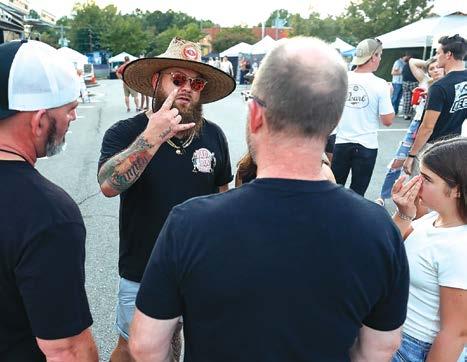



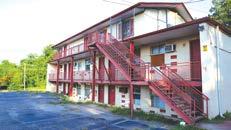












By Richard Sullins richard@rantnc.com
The Ruby and Ernest McSwain Worthy Lands Trust has made a gift of $1 million toward the final phases of construction of the new Sanford Agricultural Marketplace, to be located at the corner of Charlotte Avenue and First Streets, and open for business by late next year.
The total amount of the gift is the largest private donation to the project. Half of the amount will be awarded to the City of Sanford toward construction of the facility that will be the new home of the Sanford Farmers’ Market.
The remaining funds will be reserved for extension education and programming.
Dr. Bill Stone, director for the North Carolina Cooperative Extension Service for Lee County, said the McSwain Trust’s gift will allow the Marketplace to live out its full promise, going beyond just a building used by farmers on Saturday mornings.
“In order to do all the education, the marketing, the outreach, the support, we needed some additional funding,” Stone said. “We were dreaming big, and we did not want to have to compromise the vision of what we knew this project could be.”

It was here that the Ruby and Ernest McSwain Worthy Lands Trust stepped in.
Ruby McSwain spent her entire life in Lee County and became a noted philanthropist, particularly to programs at North Carolina State University that held her interest. In 2002, she made a significant contribution to the J.C. Raulston Arboretum that funded the Ruby C. McSwain Education Center building and complex. Among many of the honors conferred upon her by the University, she was awarded an honorary doctorate in humane letters in 2005.
Additionally, the trust she established has awarded more than $2 million in Extension and scholarship endowments that are reserved for Lee County students who attend N.C. State. Her name is seen daily by travelers along Tramway Road at the entrance to the Cooperative Extension Service Office, where ground was broken for construction on June 19, 1999 — 25 years ago this past summer.
The McSwain award is intended to be a “last mile” gift, one that will get the project to the finish line and create a one-of-its-kind agricultural marketplace in central North Carolina and the Sandhills region. But Stone says it will be much more than a just place to pick up a few freshly grown veggies for dinner.
“It’s not only going to be a farmers market,” Stone said. “It’s going to allow us to expand what we’re able to offer. We’ll potentially be able to do some weekday markets. We’ll be able to host community health and wellness events. We’ll have a shared-use commercial kitchen. We will have meeting space. There’s a performing arts stage. It is going to be the kickoff of the next portion of the East Sanford downtown redevelopment.”
The city has envisioned that the Marketplace will be one of the anchor points for its proposed “Sanford Central Green” that would create new greenspace to connect the old City Hall building on Charlotte Street with the newer one on East Weatherspoon Street.
One of the Marketplace’s key features is its location in an economically distressed portion of the city where food insecurity is a critical issue for many families. Those who participate in the US Department of Agriculture’s Supplemental Nutrition Assistance Program will have a place to shop for fresh and nutritious food at a place where they can get locally grown items and pay by using their benefits.
The facility will be home to a teaching and demonstration commercial grade kitchen, where cooking programs that are focused on nutrition will be housed. There will be space to help those that are interested in getting into a food-based business, whether full-time or just as a sideline.
Meredith Favre, N.C. State’s Extension local foods agent at the Lee County Center and the farmers market manager, said “there is an opportunity for us to help farmers either expand into value-added products or help food entrepreneurs get started. We can teach about how to make value-added products. We’ll get into labeling and bring in experts to help farmers and food entrepreneurs know what they need to do to meet food safety regulations and how to market their products.”
Other options will allow county extension agents to expand their existing programs for new and existing farmers.
“We have different programs we offer now, like Small Farm Boot Camp and farm school,” Favre said. “We’ll continue those types of programs, in addition to partnering with area community colleges like Central Carolina to offer more opportunities for new and beginning farmers.”
One of those new opportunities will come in setting up a stall in the new farmers’ market area that will offer about 60 percent more space than what is currently available to farmers in the Buggy Factory parking lot that has been used for the past several years. The new Sanford Agricultural Marketplace will be able to
accommodate about 40 vendors, up from the 25 that are now able to use the space.
The market portion will be a covered area that will be open air, assisted by fans, with much greater space to hold the crowds that range on any given Saturday from 800 to 2,000 people or more.
Groundbreaking for the project is expected to take place soon and the work is projected to be finalized around the time of the holidays in late fall of 2025. At the groundbreaking ceremony, one of the traditional gold shovels that will be used is one being brought out of retirement from 25 years ago.
It’s the same the one Ruby McSwain used in 1999 at another groundbreak -
ing — for the McSwain Center that is now home to the Cooperative Extension Service. Stone is excited to see this dream finally start to take shape and says that he can hardly wait for it to be completed.
“This is going to be a unique project with the farmers’ market, commercial and demonstration kitchens, as well as meeting and office space,” he said.
“It is going to be a community-centric facility located right in the heart of downtown. We anticipate this becoming a regional destination for people to gather to learn about, celebrate and support agriculture, local foods, and the farmers who are producing it.”



721-3303





ahegwer@smithgrouprealtyllc.com



jpate@smithgrouprealtyllc.com Leslie Oldham (919) 708-3138
loldham@smithgrouprealtyllc.com
(919) 592-1570


Jwilliams@smithgrouprealtyllc.com Linda Vance (919) 499-8635
lvance@smithgrouprealtyllc.com



The Rant provided candidates for the Lee County Board of Commissioners with four questions about their priorities if elected. They are presented here, in alphabetical order, as they were received and without edits. Voters can choose






up to three candidates, and the top three vote getters will win seats.
*Denotes an incumbent
The County’s relationship with the Board of Elections has made news recently because of a request to ban concealed carry at polling stations. Commissioners’ Chairman Kirk Smith elected not to bring the request before the board, ending discussion on the matter. Thinking more broadly about relationships between the board of commissioners and other elected and/or appointed county officials, what should be the role of a commissioner in learning about issues or problems those other officials or departments have? Do you feel it’s important for the entire board to hear about those issues?
Democrat Bob Joyce: Yes, it is important for the entire board to hear about issues of importance involving any agency or department of county government. Thorough discussion with input from each commissioner, representing the different viewpoints of citizens, makes better, more responsive government policy.
* Democrat Mark Lovick: No response.
Republican Samantha Martin: The article by Richard Sullins in the September issue of The Rant titled “Guns allowed at voting site” quoted Kirk Smith stating, “After polling six members of the Lee County Board of Commissioners, all six said ‘no’ to modifying the Concealed Carry Ordinance.” That six
commissioners said no, indicates that the six commissioners did hear about the concern of the BOE but did not agree with the need for a change.
Asking a county commissioner to place an item before the board is not the only way to bring a topic of concern before the commissioners. The public, county citizens, and other officials and departments, have channels to bring their concerns before the board of commissioners. I expect the Board of Elections will utilize one of the options to bring their request before the commissioners.
Republican Bob Quilty: First let me address some misinformation in the opening to your question. To insinuate that the answer given by the BOC to the request from the BOE is “relationship” related is somewhat disingenuous. Is “relationship” suddenly news every time someone doesn’t get what they want? Of course not, that would be childish or thin-skinned to say the least.
Chairman Smith brought the request to the Commissioner’s, who as a majority did not want to make the change to the legal concealed carry status of the building in question. He was under no legal obligation to present it at an open board meeting. However, any current Commissioner could have brought it up at the next regular board meeting, should they have so desired, so the “ending discussion on the matter” statement is misinformation.
As to the actual question, all elected and/ or appointed county officials should be working together for the betterment of the county. But let’s clarify some differences. An elected county official oversees the office they are elected to. Appointed officials
are under the board and the whole board should be involved in the resolution of any issues or problems therein.
In the case of the sheriff who is elected, he solves his own problems. He may reach out to a commissioner for advice, but whole board wouldn’t necessarily be involved. If a decision he is thinking about making is going Impact the county in any way, then the whole board of commissioners should be involved.
*Democrat Cameron Sharpe: I feel my role as a commissioner in understanding issues faced by other elected or appointed county officials is crucial for effective governance. As a commissioner I proactively engage with department heads and officials to learn about their challenges, priorities, and the impact of their work on the community. This fosters collaboration, informs decision-making, and helps identify areas for support or improvement.
Having the entire board hear about controversial issues is also important. It ensures transparency and builds consensus on addressing problems. I know there are those who do not want to discuss tough and controversial subjects publicly for fear of losing support from some voters but I feel it is part of the job. I do feel like there is no need to discuss issues beyond the scope of our board. That just wastes everyone’s time and takes away from the issues we can affect. Being an elected official is like being an umpire. You are always going to have someone not like the call you made. I just count on the voters of Lee County to know me well enough to know I made the best call I could at the time.

Republican David Smoak: I have concerns about how this question is presented, but I will answer the broader issue first. As an elected representative for Lee County, I will be empowered to bring up any issue I have for discussion during the public county meetings unless otherwise advised by our county attorney.
I want the private citizens, other government officials, or employees to bring up their issues of concern to me. Since this specific issue touches on 2nd Amendment principles and rights, I would also share my belief that the history of establishing “gun-free zones” across the nation has been a spectacular failure unless there are active and expensive security measures to enforce them.
There are numerous ways to present motions or discuss topics during every meeting and it is extremely unfair to the current Chair to say that he has solely ended the discussion on the matter regarding the Board of Elections. This situation is NOT like the US Senate Leader Chuck Schumer refusing to even bring Republican spending or border control bills up for a vote, our local system does not work that way thankfully.
I will continue to express my willingness to be the lone dissenting vote on issues or spending ordinances that I disagree with, but in general, every Commissioner needs to build a consensus of the majority to move things forward. It is my understanding that six Commissioners were informally polled about the topic which seems to demonstrate that awareness of the BOE concerns has been communicated.
Housing development has been a big topic lately, with the combined Sanford-Lee County Planning Department considering multiple proposals for new housing every single month. Housing will naturally be more dense inside the city limits, but this growth will undoubtedly impact the entire county. What role, if any, does the board of commissioners have to play with regards to new development?
Joyce: Commissioners have an extremely vital role because growth, whether in the city or county, causes ripple effects across all government services - schools, social services, law enforcement, just to name three. Both governments have worked to make communication better. There is a Unified Development Ordinance. There is a Joint Planning Committee. Going forward, we should prioritize open communication and collaboration. In other words, we have the mechanisms in place, we just need to talk more about what we want this community to look like in 30 or 40 years, make some tough policy decisions and then let our planning professionals implement those pol-
icies. I think my experience at SAGA will be a benefit here because this is exactly how we built our top notch economic development organization.
*Lovick: No response.
Martin: County Commissioners and the City of Sanford are jointly responsible for setting policies regarding zoning, incentives, and infrastructure development. Their decisions play a major role in the county’s economic development and they have a responsibility to taxpayers to keep taxes low. Lee County has challenges with access to critical infrastructure needed for development, some of which stem from the city’s insistence that developers seek annexation in order to receive water and sewer. As a new commissioner, I will be committed to pro-growth policies that make critical infrastructure available for development without compelling annexation into subordinate jurisdictions with unjustified taxation. The city and county have been very generous in providing low cost housing for those citizens who need it. Going forward, we need to be judicious in parsing out more of our
rural area for annexation and high density development, always mindful of the need for our small county to stay balanced in urban and rural features. This will help ensure Lee County remains an inviting destination location to raise a family.
Quilty: One of the biggest issues in the county is the predatory annexation of development properties by the City of Sanford. By using their control of the water and sewer in Lee County, new businesses are being forced to be annexed into the city to receive the water & sewer support needed for their business development. After some areas are annexed, they often are rezoned by the city into a higher housing density than would have been allowed if they had remained in the county. This, in turn, strains resources that the county is obligated to provide (schools, health services, social services, the jail facility, etc.) — resources the city isn’t responsible for.
A Regional Water & Sewer Authority is needed to provide equitable infrastructure treatment for all county residents, at affordable rates, without requiring annexation into the city.
I also think the commissioners can do a better job of strategic planning for future growth. We fail to adequately survey existing businesses and investors to determine their needs to grow and prosper locally.
I am committed to fostering sustained growth in Lee County. I believe that with thoughtful strategic planning and investment, Lee County will grow responsibly, balancing development and population growth with the preservation of our unique local character.
*Sharpe: The county has an immense role to play with regards to new development. We have to fund roads, schools, and utilities, to accommodate the increased population and prevent strain on existing resources. Handling the strains of rapid growth effectively is complex especially when the city has a big role in the decision-making process for housing projects. I believe if we foster strong partnerships with city officials and planning departments and jointly develop a comprehensive growth plan that addresses housing, infrastructure, and services across both the city and county we can do this the right way.

Smoak: As it stands right now, the county has little influence on larger housing projects because developers are incentivized to request annexation into the Sanford municipality to access TriRiver water and sewage services at the most favorable rates to them, not simply because of higher residential densities. As a private citizen, I have spoken about this at a Sanford public comment period in the past year, as an elected Commissioner I will attempt to resolve this issue at the lowest possible level, which could be a simple MOA between the county and city. I want to preserve a mutually beneficial relationship instead of creating an adversarial one between the city and county.
Still, this issue is fundamental to one of my goals to retain the rural nature of this county while enabling the growth in population, opportunities, and wealth, I want to live in Lee County, not Sanford County which is the direction we are heading towards. Within the county zoning authority, I would encourage creative solutions that add value for prospective homeowners and at the same time are favorable to neighbors seeking to preserve a rural community. I am opposed to allowing a flood of cheaply built
homes to flood our county simply because developers and property owners want to make a quick buck. Six years ago the Lee County master plan was published and I would commission an updated master plan based on the numerous growth factors that were not considered when the current plan was created.
Efforts have been made to schedule multiple large ticket capital improvement projects, but in some cases they are repeatedly pushed out for a number of years with the result effectively being that they may never come to pass. How would you address those projects?
Joyce: Project delays are partly unavoidable because our free market economy has its ups and downs, so tax revenues change year to year…and so do community priorities. The current annual capital project review process works well because it prioritizes health and safety needs and asset preservation. Where we can improve is more public input and increased public information. When an energized public knows about a
need and advocates for it, like the Athletic Complex project, we make progress!
*Lovick: No response.
Martin: Commissioners must be prudent and responsible when planning our capital improvement projects, looking for ways to collaborate and keep costs down while providing the necessary improvements to our county. It is the responsibility of the commissioners to say “no” to burdening taxpayers with non-essential spending when we have much-needed capital improvement projects on the horizon.
We must keep an eye on the future needs of the county (like building a new jail, new schools, etc.) and we need to limit our debt accumulation so it doesn’t outpace our ability to service that debt. I intend to focus a lot of attention on our county’s Capital Improvement Plan to ensure the project priorities match the needs of the community.
Quilty: What we need is methodical strategic planning that focuses on our statutory requirements as a county and quit putting
emphasizes the things that are nice to do, but not statutorily required.
As an example, we are responsible for having a county jail that complies with both state and federal guidelines. Our current jail is not in compliance to many of those regulations and subject to lawsuits resulting from those violations.
This is not something that just popped up. It has been known for years that we need a new jail which will be in the $100 million dollar range. Yet this board has chosen to fund an elite athletic complex, new library and other non mandated niceties’ that added together would almost fund that jail. Instead, they are using those tax monies for payment of the bonds, etc. for those projects and in doing so will necessitate our taxes going up more when we are forced to build the facilities we are obligated to.
Also, the Board of Commissioners should be the ones who are making the decisions as to what capital improvements are vital and statutory and those that are not and can be pushed out. They should not be leaving it to any one person to make those decisions and then just rubber stamping them.

*Sharpe: Managing multiple large capital improvement projects in a small county facing rapid growth requires strategic planning and effective resource allocation. Even with that, we are going to have to delay some things. There are things we can do to minimize the delays. One thing is the phase implementation. This way those affected will get some of their needs met while funding and resources are secured for the next phases.
Also, keeping the current projects on track will help. Following up to keep everyone accountable and identify potential delays early so we can minimize the delays as much as possible. Lastly, unfortunately some projects will have to be delayed but not necessarily denied. We need to regularly reassess the community needs as far as the project is concerned since we are growing and those needs will change over time. By keeping the community engaged, when time comes, we will be ready.
Smoak: I am on record at the June public hearing for speaking against the current CIP (Capital Improvement Plan) and have also recommended that cost estimates be adjusted upwards due to inflation when projects are deferred. There are three courses of action that I envision to address our capital spending plan:
1. Take an axe to this list, focus on the essential needs first and be prepared for vigorous pushback as some projects are reduced or eliminated. 2. As insinuated in the question, stand firm with the CIP project list and original timelines and vote to support the borrowing and tax increases required to support this spending. 3. Budget the projects that can be financed under current tax rates and put the most expensive and politically sensitive projects up for a public referendum, similar to what happened with the sports multiplex/athletic park.
As a fiscal conservative who wants to minimize the growth of government spending, #1 is my first choice, but I also see the value of letting the citizens decide with option #3. As a general spending priority and influenced by my own Army career in maintenance, I prefer to concentrate tax dollars on maintaining and preserving our current assets vs building new or expanded facilities. As always there are exceptions and sometimes new construction is smarter than remodeling old buildings, but I do challenge some comments about “outdated” facilities that are actually quite a bit newer than many homes that we citizens are living in.


The Rant provided candidates for the Lee County Board of Education with four questions about their priorities if elected. They are presented here, in alphabetical order, as they were received and without edits. Voters can choose up to four candidates, and the top four vote getters will win seats.
*Denotes an incumbent
Last month we asked you about the rebound in test scores following the COVID pandemic’s end, and what role a member of the school board plays in seeing those scores increase. Are you happy with where the scores are, or do you see there still being room for improvement?
Democrat Katie Eddings: There is always room for improvement in the area of academic growth for all students. I believe that as a board member my focus must be on getting qualified teachers in the classroom, which is key to academic improvement for the students in Lee County Schools.
Republican Megan Garner: No response.
Republican Carla Hooker: School leaders play a pivotal role in shaping student success. The COVID-19 pandemic impacted our academic performance, particularly by declining test scores. That reality prompted board members to reassess the








school system’s educational strategies, programs and policies. School board members were key in those efforts. The current Superintendent and his Republican-led board have advocated for and produced innovative solutions that have improved academic performance and they have implemented policies to ensure every student feels valued and supported.
While we celebrate the progress that’s already been made, we also recognize much work remains to be accomplished to get our schools back to the state median in achievement and growth. Much of the COVID-related learning gap has been eliminated, but we still have too many students not on grade level for reading and math. We must continue seeking growth, creativity, and the exploration of new possibilities to help all students thrive.
As a new member to this elected board, I expect to see continued improvement in our School System Report Cards and I will carefully evaluate all our programs to ensure we are providing the very best environment for our students to excel.
*Democrat Patrick Kelly: While it’s encouraging to see a rebound in test scores following the disruptions caused by the COVID pandemic, it’s essential to recognize that these scores are just one measure of student success. A child’s potential, creativity, and ability to thrive cannot be encapsulated by a single test result. Schools should be seen as vibrant learning environments that foster growth in various dimensions — social, emotional, and academic.
In Lee County, we excel because we offer diverse opportunities for our students,
from specialized academies to apprenticeships. These programs allow students to explore their interests and talents, providing practical, hands-on experiences that enhance their learning. As a member of the school board, I advocate for this holistic approach to education, which values diverse learning styles and recognizes that every student has unique strengths.
Test scores can provide useful insights, but they shouldn’t define a child’s capabilities or a school’s effectiveness. Instead, we should focus on creating inclusive programs that support students who may struggle academically, offering additional resources and individualized attention where needed.
By involving parents and the community in discussions about educational goals, we can ensure our strategies align with the needs of our students. Ultimately, while we strive for academic excellence, true educational success encompasses more than just numbers. It’s about nurturing well-rounded individuals prepared to contribute positively to society. In Lee County, our commitment to providing varied pathways for success helps all students thrive, both in and out of the classroom.
*Democrat Jamey Laudate: Let me say first that there is always room for improvement. Always. The biggest thing that will improve school scores is full employment. We have about 20 open teaching positions at the moment.
My daughter’s eighth grade science class is being taught by a rotation of substitute teachers, and she’ll take a standardized test at the end of the year that will be part of
West Lee’s school score. Further, there are about 60 classified position openings (bus drivers, teaching assistants, custodians, food service, etc.).
These responsibilities are filled by teachers and staff until those positions are filled. I talked to an assistant principal that drives a bus in the morning (because the school is short bus drivers), fills a classroom in the morning (because the school is short teachers), serves lunch at lunchtime (because the school is short food service workers), does her assistant principal duties in the afternoon, drives an afternoon bus route, then stays late to do more paperwork before she finally goes home for the day.
And there are hundreds of staff members just like this across our district, who are going above and beyond to fill needs each and every day. It sounds overly simple, but filling classrooms with certified teachers and allowing them as much instructional time (and planning/grading time) as possible is a formula for success.
Republican Cindy Ortiz: The rebound in test scores since the COVID-19 pandemic has been a positive sign, and I’m grateful for the dedication of our educators, students, and families who’ve worked hard to make this happen. While I’m happy with the progress, I believe there will always be room for improvement. We need to continue pushing to ensure that every student has the opportunity to succeed.
A vital part is hiring and retaining great teachers and support staff. Our educators are on the front lines, and having the right people in place is essential to student success. As a school board member, I’d
advocate for recruiting top-notch talent and providing them with the support and resources they need to flourish. Creating an environment where teachers feel valued and can focus on helping students reach their full potential is also essential. Improving test scores isn’t just about numbers; it’s about building a system that works for every child.
Democrat Shonda Ray: Upon the release of the latest school achievement report, there were notable achievements to acknowledge among schools that met or surpassed their benchmarks, while concerns arose regarding schools that fell short of their objectives.
I think there’s always space to improve in everything we do! My ultimate satisfaction would stem from witnessing all our schools consistently meeting and surpassing established benchmarks.
By examining schools that have met or exceeded their objectives, we can gain valuable insights from their experiences and identify additional innovative strategies to empower all children to achieve excellence.
*Republican Sherry Lynn Womack: Our Republican-led board certainly was responsible for replacing our previous Superintendent with a more focused administrator, Dr. Dossenbach, who has reformed our approach to achievement and growth at all grade levels. The performance audit along with establishing defined goals and expectations have provided more accountability and transparency.
The most recent annual jump in performance is just the start. We are committed to restoring our public school performance to the levels of the early 2000’s when we last measured in the top half of school districts across the state.
All the credit for our recent turnaround goes to our Superintendent, his key staff, our excellent school administrators and our wonderful teachers. I am happy with the direction we are going but will not be satisfied until we have no low performing schools. We will be the best in the state.
Dr. Chris Dossenbach has been superintendent of schools for nearly a year now. How would you rate his performance so far? Is there anything you would like to see be done differently?
Eddings: In June 2024, I retired from Lee County Schools and so I was able to see first hand Dr. Dossenbach at work. He has been in our schools, talking to our students and staff, that visibility has meant a lot to those of us working in Lee County Schools. One thing I would like to see done differently is having school improvement teams included in the search for principals and other administrative positions within their schools.
Garner: No response.
Hooker: I believe Dr. Dossenbach is doing an outstanding job, and he appears to be earning his pay. As a new board member, I hope to work closely with him to ensure we are getting the very best outcomes possible from our public schools. Over the past year, our superintendent has enjoyed very notable achievements. Under Dr. Dossenbach’s guidance, the district has successfully navigated leadership transitions, personnel changes, and complex issues, all with a focus on promoting success and improving our test scores and policies. Naturally, the county’s leadership structure has evolved so our Superintendent can implement the changes necessary to meet state standards.
Significant strides have been made under new board leadership in Dr. DOssenbach’s first full year including the board’s proactive response to the Parents Bill of Rights, where they addressed critical issues before state legislation passed. An internal investigation exposed a long-standing issue resulting in new policies on mandatory anti-grooming training and Title IX compliance. Additionally, a performance audit led to organizational restructuring, financial savings, and a more focused strategic direction. Other key accomplishments include starting school two weeks early after community consultations, improving transparency in budget presentations, and strengthening relationships with local government leaders.
Looking ahead, the board is committed to promoting academic growth through
measurable goals, holding regular retreats to align objectives with the new superintendent, and maintaining a focus on discipline, mentorship, and mental health support. These efforts will help ensure the board remains dedicated to the success of Lee County students and the broader community. The district is well-positioned to help Dr. Dossenbach build on our recent achievements.
Kelly: Dr. Chris Dossenbach’s performance as superintendent over the past year has been commendable in many areas. His efforts to engage with the community and prioritize student well-being are particularly noteworthy. Initiatives aimed at improving mental health support and enhancing communication between schools and families reflect a strong commitment to holistic education.
Moreover, Dr. Dossenbach has effectively restructured our administration, creating significant savings that can be redirected toward student resources. His data-driven approach has also led to streamlined curriculum decisions, resulting in several million dollars in savings. These financial improvements demonstrate a keen understanding of how to optimize resources for the benefit of students and educators alike.
However, there’s always room for improvement. I’d like to see more focus on finding ways to enhance teacher retention and recruitment, which are crucial for maintaining a stable and effective learning environment. Strategies such as competitive compensation, professional development opportunities, and continuing mentorship programs can significantly impact attracting and retaining talented educators.
Overall, while Dr. Dossenbach has made important strides in his first year, continuing to address these areas could further strengthen our school system. Open forums for feedback from educators, parents, and students could also help identify additional opportunities for growth. I’m optimistic about the direction in which he’s leading us and look forward to seeing further developments in the coming year.
Laudate: In my opinion, Dr. Dossenbach is off to a great start. He’s had to make some tough decisions, and he’s had to pivot quickly in a few situations. Of course the reorganization has been a large
focus in his first year. But one of the more underrated programs he implemented is the aspiring leaders program, which has already produced 3 new homegrown principals in our district. This is critical for 2 reasons: (1) it proves that we’re able to grow our own leadership, and (2) it shows teachers and staff that we are very serious about providing a career path and career advancement in Lee County Schools.
The focus now changes from establishing leadership, to supporting leadership and helping them reach their goals. The board of education plays a role in this leadership support as well, it’s not just Dr. Dossenbach and his central office leadership team. As I have said before, I think our middle schools need to be a point of emphasis for the next board.
I am extremely excited about the 3 new middle school principals that started this year. Providing them support and resources will lead to quicker improvement.
Ortiz: Dr. Dossenbach has done a great job in his first year as superintendent. His 18 years of experience as a teacher, principal, and more before stepping into this role gives him a valuable perspective on what our educators and students need to thrive.
While his leadership has been solid, I believe there are areas where we can grow even more. I’d like to see more transparency in decision-making and stronger communication between the district and families. Engaging teachers, support staff, and parents more actively in shaping the direction of our schools is essential for long-term success.
I’m also hopeful that Dr. Dossenbach will continue focusing on addressing staffing challenges, ensuring that we’re hiring and retaining the best people to support our students. Overall, I’m confident in his commitment to our community, and I look forward to (hopefully) working together to continue building a stronger future for our schools.
Ray: Upon Dr. Dossenbach’s formal appointment as School Superintendent, the community responded positively. His prior leadership experience at Southern Lee High School and tenure as Interim School Superintendent had established him as a respected leader. With his roots in Lee county, he brings a distinctive perspective
that integrates historical understanding, present-day awareness, and forward-thinking vision for future demands. He has shown grace under fire and remained steadfast at keeping children a priority with a team approach.
Having successfully navigated his first year as School Superintendent, he has received commendations from students, staff, parents, and the community at large, reflecting his effectiveness in the position. As I stated in my previous response, there is always space for improvement. I would like to have deeper collaboration between all stakeholders in our public schools.
Womack: Dr. Dossenbach has implemented much needed changes across Lee County Schools. He has tackled every mandate from our board with transparency and accountability. He welcomed the performance audit and immediately set about implementing programmatic and procedural changes to achieve greater efficiencies in operations and curriculum.
No doubt, Lee County Public Schools will achieve even better results in coming years. Dr. Dossenbach has the full support and confidence of the School Board and we expect him to continue striving for excellence.
Under Dossenbach’s tenure, a great number of personnel changes have taken place both in the Central Office and in the administrations at individual schools. What are some of the things you’re looking for in terms of whether the county’s new leadership structure is a success?
Eddings : Their ability to be transparent and how they address questions or concerns from the community, teachers, students and the significant adults in the lives of our students. To be strong independent leaders within scope of their responsibility. Willingness to work at schools during open houses, testing, graduations and other times when additional support is needed at our schools.
Garner : No response.
Hooker : Sometimes, change is necessary for progress. I believe Dr. Dossenbach acted in the best interest of the school system and its individual schools, particularly regarding Central Office and administrative staffing. He is experienced, competent, and well-qualified. I fully support his decisions so far. In order to continue improving, I would like to see greater accountability from school administrators, improved communications with parents, and further refinement of policies.
The recent school performance audit uncovered significant findings that led to reorganization and financial savings. We need these recommendations through to completion.
The board also addressed the Parents Bill of Rights proactively, six months before state legislation passed, demonstrating a commitment to student and parental rights. These accomplishments reflect a strong foundation for continued growth, and I believe further improvements will build on the momentum, reflecting positively on all the changes in leadership.
Kelly : Under Dr. Dossenbach’s tenure, the numerous personnel changes in both the Central Office and individual school administrations are significant. To gauge the success of the county’s new leadership structure, I’m looking for several key indicators:
1. Improved Communication: Effective communication between the Central Office, school administrations, teachers, and parents is crucial. I’ll be assessing whether the new structure facilitates clear, open channels that promote collaboration and transparency.
2. Student Outcomes: Ultimately, the impact on student performance is a primary measure of success. I’ll be monitoring trends in test scores, graduation rates, and overall student engagement to see if the changes lead to improved educational outcomes.
on teacher morale, professional development opportunities, and retention rates will provide insight into whether the new administration supports and values its staff.
4. Resource Allocation: I’ll be looking at how effectively resources are allocated under the new structure. This includes not just financial resources, but also support services and instructional materials that directly impact the classroom experience.
5. Community Engagement: Strong leadership should involve the community in decision-making. I’ll assess how well the new administration engages parents and stakeholders, seeking their input and addressing their concerns.
Overall, these indicators will help determine if the leadership changes are translating into a more effective and supportive educational environment.
Laudate : First I’ll discuss central office reorg. Fiscally, it has been a success because it has led to almost $300,000 in annual savings. And as a reminder, the performance audit last year showed that Lee County Schools had one of the smallest Central Office outlays when compared to peer school districts. Now, we need to hear from the staff at each of our 17 schools (principals, teachers and staff)... are they able to do their jobs and get the support they need?
Do further adjustments need to be made? As for the 10 new principals in Lee County Schools, of course math and English proficiencies, performance grades, and growth grades will be important data to monitor. High school programs (trade programs, NAF academies, CCP, JROTC, etc.) need to remain strong and supported. Extracurricular clubs and teams are important as well. All lead to well-rounded students.
But as I said before, there is always room for improvement. Superintendent and staff should be free to make changes they think will advance educational outcomes.
tenure, I think it’s important to focus on a few key factors to assess whether the new leadership structure is successful. First and foremost, I’m looking for continuity and stability within our schools. Leadership changes can be disruptive, so it’s crucial that these transitions are smooth and that the focus remains on supporting students and teachers.
Secondly, I’d like to see whether these new leaders are fostering a positive culture that encourages collaboration and innovation. Strong leadership isn’t just about decision-making; it’s about inspiring the entire school community to work together toward common goals.
Finally, success will also be measured by results—whether in the form of improved student outcomes, better teacher retention, or an overall improvement in the atmosphere and morale within our schools. I’ll be looking to see how well these new leaders address challenges and if they’re driving meaningful improvements that benefit students and staff.
Ray : Emotional responses often arise from periods of change. Amidst team changes, the team’s focus on making children the top priority must endure, driving every action and decision. The key performance indicator of the new leadership structure’s effectiveness will be student academic achievement. My focus would also extend to feedback from educators and support staff highlighting positive aspects of their work environment.
Womack : The bottom line for our stakeholders is performance. If the county’s public school leadership is well structured, it will show up in our school report cards. The board closely examines all aspects of our growth and performance as measured by the state, and we work with Dr. Dossenbach to make adjustments to staffing or programs where they are needed. Many of the changes in staff and structure came from the performance audit recommendations.
3. Teacher Satisfaction and Retention: A successful leadership structure should foster a positive work environment for educators. Surveys
Ortiz : With the personnel changes that have taken place under Dr. Dossenbach’s
The new leadership has already improved morale and the staff and teachers are motivated to bring change to our schools. You will not find more dedicated and excited principals and assistant principals willing to take on the challenges facing our public schools.
Efforts have been made to schedule multiple large ticket capital improvement projects, but in some cases they are repeatedly pushed out for a number of years with the result being that they may never come to pass. How would you address those projects?
Eddings: Immediate needs must be put at the top of the list, Lee Early College NEEDS a building and that is just one project that must happen and can no longer be pushed out. As a board member I want to see the improvements that are being proposed, which means I need to go to the school campus and have conversations with our maintenance personnel.
Garner: No response.
Hooker: Transparency in budgeting and open communications with commissioners are key. For the first time ever, last year the Lee County School Board presented its budget to county commissioners as required by law, rather than relying solely on the Superintendent to make the case for the school system’s budget. Monthly meetings between the board chair, county commissioners, and the county manager have strengthened this collaboration.
Leadership has actively researched grants to ease the tax burden on our community, ensuring responsible and efficient use of resources. Now, our many high-cost capital needs require a business case that convinces commissioners that our needs merit taxpayer funding. As a new board member, I will work tirelessly to help build that business case so we can fund our stadium improvements at LCHS, the auditorium and additional classroom space we need at SLHS, among other important capital projects. I am confident we will make the necessary adjustments to the county’s Capital Improvement Plan in the coming year to program for our future capital needs.
Kelly: Addressing delayed capital improvement projects requires a proactive and strategic approach. Here are several steps I would consider:
1. Prioritization and Assessment: I would conduct a thorough assessment of all pending projects to prioritize them based on urgency,
impact on students and staff, and available funding.
2. Stakeholder Engagement: Engaging with stakeholders—teachers, parents, and community members—can provide valuable input on which projects are most critical. Their perspectives ensure we address the most pressing needs.
3. Transparent Timelines: Developing clear, realistic timelines for each project helps set expectations. Communicating these timelines to the community fosters transparency and accountability.
4. Collaboration with County Commissioners: Partnering with county commissioners is vital for securing necessary funding and support. By working closely with them, we can align our goals with county priorities and explore shared funding opportunities, ensuring our school improvement projects are included in broader community planning.
5. Funding Strategies: I would explore diverse funding options, including grants, partnerships with local businesses, and potential bond measures. Identifying multiple funding sources can help prevent delays due to financial constraints.
6. Regular Updates: Implementing a system for regular updates on project statuses keeps the community informed and engaged. This also helps identify potential obstacles early, allowing for timely adjustments.
7. Long-Term Planning: Finally, developing a long-term capital improvement plan that outlines future needs and funding strategies can help avoid similar delays in the future. By taking these steps, we can ensure that essential capital improvement projects positively impact our schools.
Laudate: This is one of the reasons I helped create the budget ad-hoc committee between board of education (BOE) and county commissioners, so that we could have an ongoing dialogue for General budget items and for Capital projects. The BOE
needs to continue that dialog and do our best to advocate for a higher priority from the county for educational items. County Commissioners control the purse strings and they have the tough task of itemizing and funding these school capital projects among all of the other county projects (parks, library, community college, etc.). I commend our county commissioners for their work on our capital requests. I think the BOE also needs to continue to be fiscally responsible with our requests.
For example, we fixed the home side of Paul Gay Stadium last year with no additional funding from the county. The first estimate was $1,000,000-$1,500,000, and rather than just accepting that estimate and passing it along to the county commissioners, the Facilities and Technology committee that I chair pushed for a second opinion. We ended up repairing at a cost just under $250,000. We replaced the chillers at Lee County High School which were around $1,000,000 with no additional funding from the county. I’m very proud that Lee County Schools is positioned and structured to absorb these larger ticket items without involving the county. Another improvement Dr. Dossenbach has made is to aggressively pursue other avenues for funding these capital projects, so that it doesn’t fall on the county. Last year we applied for grants for four capital projects and were unfortunately turned down for all four, but we applied for another grant this year for the Southern Lee High School auditorium construction and the Lee County High School auditorium renovation. If there are other grant opportunities that keep costs off taxpayers then we will pursue those as well.
Ortiz: Capital improvement projects ensure our schools provide safe, modern, and effective learning environments. When these projects are delayed repeatedly, it can negatively impact both students and staff. We need a more strategic and transparent approach to planning and executing these projects to address this issue.
First, it’s important to prioritize projects based on urgency and need. Schools with aging infrastructure or overcrowding must take precedence, and we should communicate why specific projects are prioritized. I would also push for a realistic timeline with built-in accountability measures to ensure that projects don’t keep getting pushed out.
Additionally, we need to use existing resources better and work with local leaders to ensure the funding allocated for these projects is used effectively and efficiently. Delays often occur due to budgeting constraints, so we must ensure that capital improvement projects remain a priority in our financial planning.
Lastly, I’d focus on increasing transparency and community involvement. By keeping the public informed about the status of these projects and the reasons behind any delays, we can build greater trust and rally support for moving these improvements forward.
Ray: Maintaining capital improvements in our public schools is crucial. Investing in these upgrades is essentially investing in our children’s long-term success. Partnering with county colleagues in a collaborative mindset, we must emphasize the imperative of tackling these projects with expedition and purpose. While envisioning future growth and needs that come with that growth, we must remain proactive with our investments and balance it with fiscal responsibility.
Womack: The board has already begun working on increasing communication with the County Commissioner and for the first time in history our board presented the budget request to their board. This task had previously been delegated to the Superintendent. Your question stating “the result being that they may never come to pass” is not factual. The School Board has an obligation to build a business case for all our capital needs. If we fail to articulate those needs in a convincing fashion, we may suffer harmful delays in completing important expansions and new construction.
We plan to expend even greater effort in documenting and coordinating our infrastructure needs in the coming budget year to get a few projects back on track. I am confident we will be successful because I know our Republican-led Board of Commissioners is equally committed to public school excellence in Lee County. The School Board and Superintendent will continue to aggressively research multiple grant opportunities to decrease the tax burden on our county by using state and federal funding and other DPI resources, where available.
Lending Paws A Hand, a foster-based animal rescue group in Lee County, was announced as a finalist in the Animal, Wildlife & Marine Welfare category of the fourth annual ‘Defender Services Awards’ presented by Land Rover, Chase Bank and Disney.
Public voting, which will take place Oct. 2-17, will ultimately decide the winning organizations for each category. The winning organizations will each receive a new Defender 130 vehicle that will be fully customized to best address their needs, and awarded $25,000 by their category sponsor, empowering them to further their missions.
Lending Paws faces four other organizations in its category, which includes community pounds and shelters, wildlife rescue organizations and marine conservation groups. The other finalists hail from Belton, South Carolina; San Pedro, California; Washington Township, Ohio; and Cochrane, Alberta (Canada).
“I never thought in a million years we would even have a chance at this award. It is such an honor to be recognized as a finalist and to represent North Carolina,” said Kelsey Quinn, a Lending Paws a Hand volunteer. “It would be absolutely amazing to be the top winner of this award, but more than anything I hope by watching our video and voting, others will recognize the importance in supporting animal welfare in North Carolina and the Lee County community.
“Our state is small, but we rank third in the country for euthanizing shelter pets. Change needs to happen and by winning this award, Lending Paws a Hand can make an impact in being a part of that change.”
Since its founding in 2014, Lending Paws a Hand has helped find loving homes for more than 600 pets. The organization continues to educate and network within the Lee County community, including initiating the Ichi and Luke Legacy Fund to go towards helping family pets with vetting such as spay and neuter and helping the county shelter with purchase of vaccines. Winning this award, Quinn said, will help continue

Southern Lee High School cut the ribbon on a new Cross Country course ahead of their first home meet in September. The course was the dream of Head Coach Robin Showalter and brought to life by the generosity and support of Caterpillar of Sanford, which helped provide some equipment and an operator to clear the new sections of the trail.
our rescue efforts and support additional programs for the Lee County Community.
To view all the finalists and their videos, search “Defender Service Awards” on the landroverusa.com website.
The winning organization from each of the six categories will be announced at this year’s Destination Defender event in November at Calamigos Ranch in Malibu, California.
Rubber ducks will race down the Deep River to benefit COTA (Children’s Organ Transplant Association) for Team Ken and Outreach Mission, thanks to a joint fundraiser by the Sanford and Jonesboro Rotary clubs. Participants can adopt ducks for $5 each. The race will kick off on at 2 p.m. on Oct. 6 at the Camelback Bridge.

The event was rescheduled from Sept. 29 due to high river levels associated with Hurricane Helene.
The first 10 ducks to cross the finish line will win a prize. Prizes include a $250 cash prize, a $100 Food Lion gift card, a 50-minute massage from The Now, Starbucks gift cards, Applebee’s gift cards, a Town and Country gift basket and gift card, a wine and relax basket and a $300 Essential gift basket from Pinehurst Medical Dermatology.
A portion of the proceeds from ducks adopted through the Sanford Rotary Club will benefit COTA for Team Ken in honor of Ken Moss to assist with transplant-related expenses. Moss is awaiting a liver transplant due to a single-cell genetic disorder called Alpha-1 Antitrypsin Deficiency.
“Rotary fundraisers are vital in transforming lives and uplifting our communities,”
says Sanford Rotary Club president Darla Molina. “COTA for Team Ken exemplifies the type of initiative that Rotarians passionately support, showcasing our commitment to service above self.”
The Jonesboro Rotary Club will dedicate a portion of the proceeds from its duck adoptions to Outreach Mission.
“I am proud to be part of a group that stands united, always ready to support fellow Rotarians and the broader community,” says Meg Moss, wife of Ken and a member of the Sanford Rotary Club.
“We are grateful for the support COTA for Team Ken has received from the Rotary clubs and the Sanford community.”
To adopt a duck, contact a member of either Rotary club or make an online donation via Paypal at www.paypal.me/ rotarysanford. Make sure to include “rubber duck” in the comment field.
Oxide Gallery of Fine Art will present Galerie Macabre, a group show featuring work by over a dozen North Carolina-based artists, Oct. 3-26. The gallery will be open for a costume optional First Saturday Public Reception from 4-7 p.m. on Oct. 5, with music, refreshments and an artist meet and greet.
“Galerie Macabre is a celebration of the dark autumn — the spooky, the sinister and the mildly scary,” the gallery stated in a press release in September. “The Gallery will transform into a haunted experience with a new front window display created by local haunt enthusiasts, our monthly fine art exhibition and themed work in the N.C. Art Gift Shop — suitable for all ages to safely explore and enjoy.”
Oxide Gallery will also host the Lee County Fine Arts annual Artstober Gala and Auction, a fundraising event on Oct. 19. Tickets and information can be found at artstober.org.

Local attorney Brad Salmon was appointed by Governor Roy Cooper to serve as District Court Judge for District 12 covering Lee, Harnett and Johnston counties.
“I am humbled by this appointment,” Salmon said. “It is an honor to again serve as a District Court Judge, and I will do my very best to promote justice and ensure confidence in our judicial system.”
Salmon fills the seat left vacant by Judge Michael Onufer, who resigned following his primary loss to Republican Brian Lewis. Lewis is running unopposed and will assume the seat following the November election.
“Brad Salmon’s previous experience in this role ensures he is a prepared and capable judge,” Cooper said in a press release. “I am grateful for his service to his community and his willingness to step up and serve the people as a District Court Judge.”
Salmon, a Democrat, was a founding partner of the Salmon Law Firm in Lillington. In 2015 and 2016, Salmon served

Community was on full display at Broadway Elementary in September as the school kicked off their celebration of Hispanic Heritage Month with the annual talent show. A packed auditorium was on hand to provide the encouragement young people need to pursue their passions and the support they need to thrive.
in the North Carolina General Assembly representing Harnett and Lee Counties (District 51).
Salmon was a previous District Court Judge and a 2022 candidate for the North Carolina Court of Appeals. Most recently he served as a Lee County Magistrate. He is a graduate of North Carolina State University and Campbell University School of Law.
MCNC, the technology nonprofit that builds, owns and operates the North Carolina Research and Education Network, held a groundbreaking ceremony at Central Carolina Community College on Sept. 5 to signify the start of MCNC’s HERO Project.
In 2023, MCNC received $11.2 million from the National Telecommunications and Information Administration for the project. Funded through the federal Internet for All initiative, the project will support improvements to broadband access and affordability in central and southeastern North Carolina.

More than 500 eighth grade students from Lee County middle schools had the opportunity to get a great overview of the wide range of occupations available to them in the healthcare field as FirstHealth of the Carolinas partnered with Lee County Schools’ Career and Technical Education Department to host the first Health Career Fair at the Dennis A. Wicker Civic Center.
FirstHealth brought staff from an assortment of departments and specialties to help give students a variety of exposure to career pathways available to them once they graduate. Staff on hand provided insight into their field of medicine while engaging with students in hands-on demonstrations of various tools and techniques used in their specialty.
Cayden, an eighth grade student from SanLee Middle, enjoyed the exhibits, particularly the Food and Nutrition display that included a cooking demonstration. “It was cool to see the food being cooked and for them to check your pulse,” he said. “I might be interested in being an EMS Driver, because you get to drive around and see different things and help people.”
Berni Szczepanski is the chief people officer with FirstHealth of the Carolinas and she noted that they were excited to partner with Lee County Schools to offer this event to students. “We have a large presence here with several great facilities and providing EMS Services, so we thought this would be a great opportunity to be out in our community to connect with students and really build the future healthcare workforce.”
“This fair is really a great partnership to allow our students to explore career options and see if they may want to pursue some classes in our Academy of Health and Life Sciences at Lee County or Southern Lee High Schools,” said Gary Hart, director of career and technical education for Lee County Schools.
“Our ultimate goal is to provide opportunities for our students to learn about things that they may be passionate about and give them the space to pursue those passions and interests in the classroom.”

“We really want to open up student’s awareness to the wide variety of careers available in the medical field. Most of the time, people think of physicians and nurses, but there are so many other ways to have a career in health care.” — Berni Szczepanski, chief people officer for FirstHealth of the Carolinas
Dr. Shawn Williams, a former administrator at the MINA Charter School in Sanford and a one-time Democratic chairman of the Lee County Board of Education, was charged in September with three counts of embezzlement, according to the Sanford Police Department.
Williams last made headlines in June 2023, when it was revealed that he’d been suspended as the school’s lead administrator pending an investigation into unspecified human resources and financial matters.
Major Vinnie Frazer of the Sanford Police Department said the three counts of embezzlement are for allegedly taking more than $100,000 in school funds, for allegedly changing passwords to school accounts and for allegedly taking files that belonged to the school.
Frazer said the school reported the embezzlement in July 2023 and Williams was indicted by a grand jury on Sept. 9. The Lee
County Sheriff’s Office served the warrant on Sept. 17. Frazer said the investigation is ongoing and further charges are possible.
Sometime after his suspension, MINA and Williams parted ways, although the circumstances were unclear at the time of this writing. Later, the school changed its name to Rising Leaders Academy.
In addition to his work in education, Williams had been involved as a pastor with God’s Promise Church. He was on the Lee County Board of Education from the late 2000s until 2012, and ran again unsuccessfully in 2014.
Williams was placed in the Lee County Jail under $600,000 secured bond.
Palm cards advertising the candidacy of David Smoak for the Lee County Board of Commissioners were apparently inserted into print copies of The Rant Monthly in at least
one location in Lee County in September without the knowledge or consent of LPH Media, which owns and operates The Rant.
A source confirmed that the palm cards fell out of copies of September’s The Rant Monthly that were picked up recently at the Carolina Trace Country Club, and that all remaining papers at the site contained an insert. Insert materials placed in newspapers typically constitute paid advertising, and The Rant had no agreement for advertising in place with Smoak. Unpaid advertisements for political campaigns could be considered an in kind contribution from a business, which is illegal under North Carolina law.
Three other local candidates for public office paid for advertising in the September edition of The Rant Monthly
Smoak, a Republican seeking one of three at large seats on the Lee County Board of Commissioners, had not responded to an email explaining that LPH Media does not authorize placement of any items in the publication without consent, and asking if palm cards that may have been inserted in papers at any other pickup locations be removed.

Last spring, the Deep River Elementary Student Council set a monumental goal of raising $35,000 for new playground equipment. In September, after successful community fundraising by students and a $35,000 donation from Wake Stone Corporation, the student council not only surpassed their fundraising goal, they were able to upgrade playground equipment for both the upper and lower grade playgrounds at the school. All together with the boost from Wake Stone Corporation and several other community partners, the students and staff at Deep River were able to raise over $60,000 in their single fundraiser for the year.
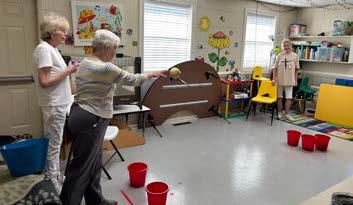
The Mamers community in western Harnett County near Broadway held its second annual Senior Games, organized by Jenny Allen, a retired physical education teacher from Boone Trail Elementary School. Allen had 11 stations set up this year with groups of four playing cornhole, basketball, ax throwing, checkers, croquet and more. After all the fun was had, a hot dog lunch was provided, and ribbons were presented to the winners.








The second annual Triple Crown Charity Car Show will return to the Dennis A. Wicker Civic Center from 9 a.m. to 3 p.m. Just like the 2023 show, the event will feature three classes of vehicles: the Automotive Legends Exhibit featuring 31 legendary cars; the Selects Display featuring 30 restored and custom vehicles; and the Open Car Show, open to anyone with a vehicle and $20 to enter. Admission is free, and $5 to view the indoor displays. All proceeds will benefit the Lee County Education Foundation, the Christian United Outreach Center and the CCCC Auto Restoration program.
The Rant Monthly's community calendar has returned, and we're doing our best to track down everything going on in Sanford and Lee County. Send us your events by email at billy@rantnc.com and include the date, time, location and a brief description.
OCT 3-26: Galerie Macabre Exhibition comes to Oxide Gallery of Fine Art in downtown Sanford. The event will include a First Saturday Opening Reception on Oct. 5 from 4 to 7 p.m. Galerie Macabre is a celebration of the dark autumn — the spooky, the sinister and the scary. The gallery will transform into a haunted experience, suitable for all ages. The gallery is open Tuesdays through Saturdays, 11 a.m. to 5 p.m.
OCT 4: Tuesday Night Music Club will perform at Smoke & Barrel in downtown Sanford at 8 p.m.
OCT 4-19: Buchanan Farms, located at 2508 Broadway Road, will host its Fall Harvest Festival Friday and Saturday nights, Oct. 4-19, from 6 to 10 p.m. Corn maze, decorated hayride, pumpkins, bounce houses, corn slide, wagon train and more. Tickets are $12 for ages 3 and up.
OCT 5: White Hills Farms will celebrate its Fall Festival from 9 a.m. to 4 p.m. The festival will include a corn maze and tons of activities and local vendors. The farm is located at 5020 South Plank Road in Cameron. Visit whitehillsfarms.com.
OCT 5: Family Day @ the Raleigh Exec Jetport is a free community aviation celebration offering fun for all ages. Experience corporate jets, vintage airplanes and recreational aircraft. Enjoy plenty of music and food from 10 a.m. to 3 p.m. at the jetport, located off U.S. 1 at the Farrell Road.
OCT 10: The Band of Oz will perform at Kiwanis Family Park at 6 p.m. as part of the Sanford Parks Summer Concert Series. Free admission. Bring lawn chairs or blankets.
OCT 11: Sanford Parks will host Family Movie Night at Kiwanis Family Park at 6 p.m. with the movie “If.” November will wrap up the series with “Inside Out 2.”
OCT 10-27: Temple Theatre’s next mainstage production, “Ring of Fire” will run from Oct. 10-27. The songbook of Johnny Cash comes to life in this musical about love and faith, struggle and success and the healing power of home and family. More than two dozen classic hits — “I Walk The Line,” “A Boy Named Sue,” “Folsom Prison Blues” and the title tune — performed by a multi-talented cast, paints a musical portrait of The Man in Black that promises to be a crowd-pleasing salute to a unique musical legend. Tickets available at templeshows.com.
OCT 12-19: The Sanford Brush & Palette Club’s 59th annual Art Show, celebrating 60 years of art in Sanford, will be held at the Harper Center in First Presbyterian Church from 10 a.m. to 6 p.m. Oct. 12-19. Explore hundreds of pieces of original art, meet local artists, and see art demos. Enter to win door prizes and raffles. Unique holiday gifts available in the Holiday Gallery. Visit the special Art After Dark event. The Bowl & Vessel
Show, a showcase of member potters, will be held again along with the Art Show.
OCT 12: The Sanford Area Growth Alliance’s Children’s Business Fair will be held at 8:30 a.m. at 115 Chatham St. in downtown Sanford. Come support local young entrepreneurs as they showcase their business skills and creativity.
OCT 17-19: The Boo & Brew Ghost Tour returns to downtown Sanford. The tour includes a pub crawl and self-guided audio tour connecting local shops, restaurants and bars with a bone-chilling ghost story. Go online to visitsanfordnc.com to learn more.
OCT 18: Erik Hawks performs at the Smoke & Barrel in downtown Sanford from 8 to 11 p.m.
OCT 19: White HIll Farms will host a Fall Pop-Up Market from 9 a.m. to 4 p.m. The farm is located at 5020 South Plank Road in Cameron. Visit whitehillsfarms. com.
OCT 19: The Lee County Fine Arts Artstober Gala and Auction will be held at the Oxide Gallery of Fine Arts in downtown Sanford from 5 to 8 p.m. The cocktail-attire fundraising gala features live music, champagne and wine, catered refreshments and a live and silent auction with all proceeds benefiting the mission of Lee County Fine Arts.
OCT 19-20: The Lee County Community Orchestra will perform “Victory at Sea,” featuring the music of Richard Rodgers and Robert Russell Bennett. The concert at the Mann Center in Sanford will be held at 7:30 p.m. both nights.
OCT 26: HAVEN of Lee County will present the 23rd annual No Scare Fair from 11 a.m. to 4 p.m. at the Dennis A. Wicker Civic Center.
OCT 26: The Sanford Trail Festival will be held at San Lee Park. Presented by Back to Dirt Conservancy, the festival will include different level rides, races, enduro, short track, clinics, raffles, prizes, food trucks, vendors and more. Enter to win an exclusive BTD bike.
OCT 26: First Presbyterian Church and Edgewood Presbyterian invite the public to their Pumpkin Trail from 6:30 to 7:30 p.m. at 203 Hawkins Ave

OCT 26: Downtown Sanford will host its annual Trick-or-Treat event for children at participating businesses.
NOV 1: Downtown Sanford Inc. will kick off the holiday season with Holiday Night Market from 5 to 9 p.m. The market will feature the best local handmade artists, food trucks, games on the lawn, music, winter-themed activities, a holiday photo booth and a visit from Santa.
NOV 3: Downtown Sanford will host a Downtown Holiday Open House from noon to 4 p.m. The Temple Theatre Company will fill the streets with carolers as shoppers get a first glimpse of all things Christmas from participating downtown businesses.
MONDAYS: Circle M City in Sanford hosts Monday Music Jam at 7 p.m. every Monday. The town comes alive with pickin’ and singin’ … guitars, mandolins, banjos, fiddles, bass and their players perform inside the Livery Stable. Pull up chairs to listen or join in. Families are welcome. Located at 74 Cowboy Lane.
WEDNESDAYS: Lee County Libraries will host Baby Story Times (0-18 months) and Toddler Story Times (1-3 years) at 10 a.m. and 10:45 a.m. respectively on Wednesdays throughout June at the library in downtown Sanford.
THURSDAYS: Wild Dogs Brewing hosts a “pop-up bookstore and bottle shop” every Thursday from 4 to 10 p.m.




ACROSS
1. Furry bamboo consumer
6. Cuban dance syllable
9. 100-meter race, e.g.
13. S-shaped moldings
14. Excessively theatrical actor
15. Chap
16. Will alternative
17. Sailor’s affirmative
18. At full speed
19. *Cause for fall celebration
21. *Apple-related game
23. European Union, acr.
24. Hawaiian tuber
25. Pen on a farm
28. Color of a bruise
30. *Pumpkins and squash, e.g.
35. “Give me your tired, your ____....”
37. “____ Free,” movie about lions
39. Disdain
40. Caribbean color
41. Shiny suit
43. Spaghetti aglio and ____
44. Peevish
46. Half a round, in golf
47. ____-do-well
48. Battles royale
50. Change for a twenty
52. Banned insecticide, acr.
53. *Back-to-School event
55. Hermey the Dentist
57. *Apple sauce
61. *____ weather
65. Cell phone bill item
66. Bar association
68. Wombs

69. Begin, began, ____
70. Cut grass
71. Romanov rulers
72. Command with “at”
73. Stiff grass bristle
74. “Hobby” animal
DOWN
1. Beckham of “Spice Girls”
2. Turkish honorific
3. Not far
4. Look into
5. In the Land of Nod
6. Online conversation
7. *Cushion for certain seasonal ride
8. Naked protozoa
9. Obtuse, as in person
10. ____ bowl, frozen dish
11. Largest human organ
12. Precedes Kong
15. Hindi courtesy title, pl.
20. Modern-day aqua-lung, acr.
22. Domain
24. Wood-eating house hazard
25. Involuntary contraction
26. Chef’s headgear
27. Phil Collins’ “____ Be in My Heart”
29. *Maze plant
31. Upward and onto
32. Wide-____ notebook
33. *Like leaves in fall
34. Stall call
36. *Much-used fall garden tool
38. Not any
42. Extend subscription
45. Unquestioning ones
49. Fraternity house
51. Miss Marple, e.g.
54. “Is Your Mama a ____?”
56. Dom DeLuise in 1980 role
57. Rubik’s puzzle
58. Away from port
59. The state before riches?
60. Malaria symptom
61. Saw, sawed, ____
62. Drop of sorrow
63. Makes a mistake
64. Precedes shine
67. Gift topper


